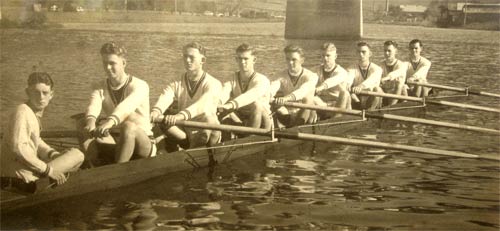The Built Environment - Box Hill
We grew up in Box Hill South in close proximity to Surrey Hills where our family has had an association for five generations. 28 Moore Street was our family home.We all spent our childhood and early adult years there, before moving out on our own. The family ventured out into Box Hill in 1946 when our parents bought a block of land in a new subdivision. They paid one hundred pounds plus ten pounds in taxes. Jim and Alice also looked further out in Donvale, where, for a fraction of the cost, they could have purchased two acres of bush. Unfortunately this was not an option as there was no public transport and we did not own a car.
After the war, Box Hill South was opened up for new housing. The City of Box Hill revised its land valuation system and residential subdivision started to boom across the municipality. The small holdings of mixed farming and orchards, were quickly replaced by the unmade road network of the subdivisions. Electricity and gas were provided, but no sewerage until the 1950’s, so it was outside toilets for all.
Our parents could not afford to have the house built, so Jim decided to build it himself. He bought a book on basic carpentry and the tools, all hand tools of course, and proceeded to build. The house is still there today, straight as a die.
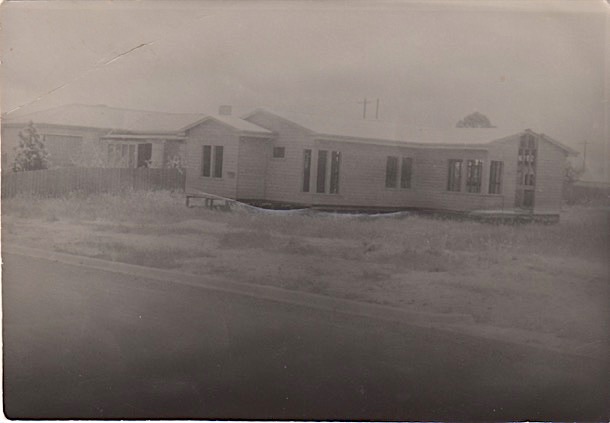
It was a very liveable and rather nice design, set on stumps, weatherboard cladding and with a low slung, pitched roof. It had the standard three bedrooms ,one bathroom, kitchen, dining room, lounge room and laundry. When first built there was an outside toilet attached to the single garage that also had a chook pen attached to it.
Over time, the surrounding paddocks filled with houses and our house changed a little too. The view of the Dandenongs from the french doors in the lounge room disappeared, the toilet moved inside and our grandparents built a flat on the back. The addition of the rumpus room and flat spoilt the spaciousness of the living rooms and the back garden. The old weatherboard garage, toilet and chook pen were removed and a new double garage and new chook pen took the new additions to the back fence.
Little appears to have changed externally to the house since Mum sold it about 1981.
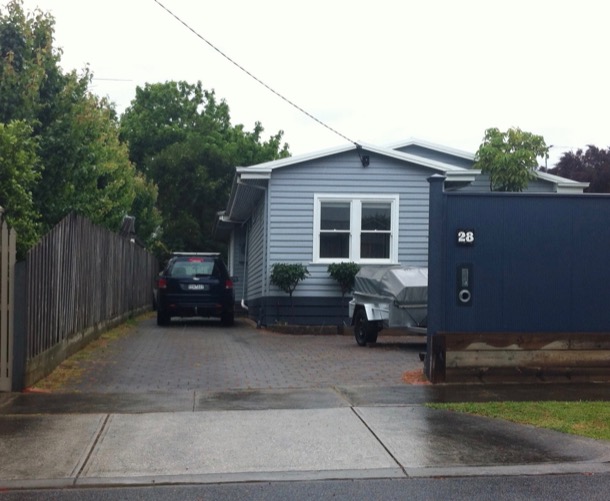
When we were children, Wattle Park itself consisted of large trees with mown grass underneath, like a traditional park, but with native trees and grasses. It was owned and maintained by the Tramways Board, responsible for the tram system in Melbourne. The Tramways brass band played in a rotunda every Sunday in the park. Nowadays those grasses are no longer mown. It looks much more like remnant bushland.
The 137 acres opened as a public park in 1917.
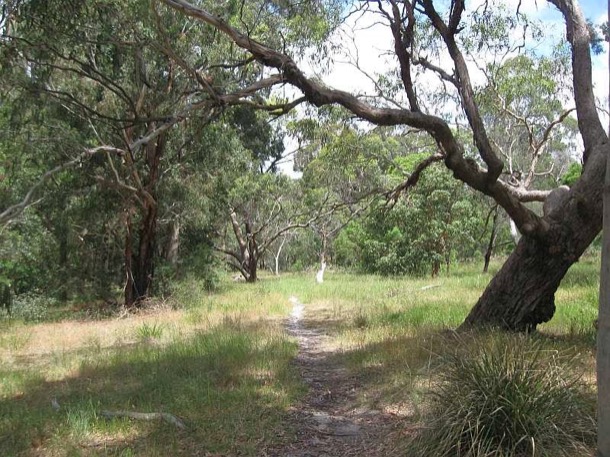
The chalet, designed and built by a Tramways architect, opened in 1928. it was promoted as a dance hall and wedding reception venue and, amazingly, it still is. It is listed on both the Heritage Victoria and National Trust Registers.
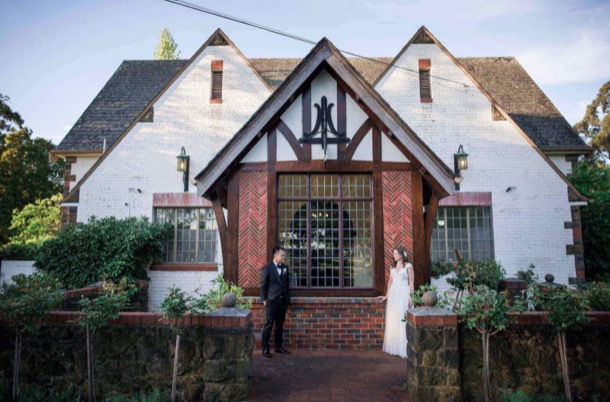
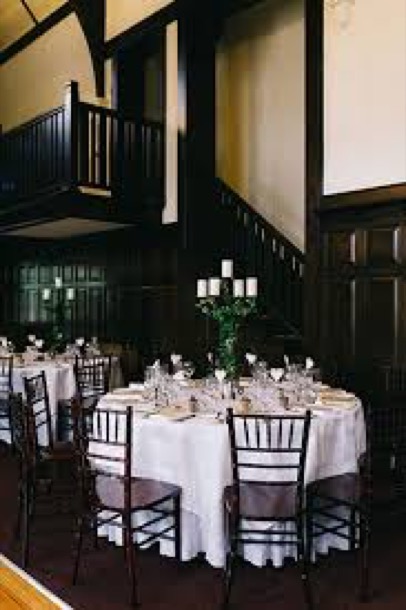
Our own parents’ wedding reception was held there in 1945, after they had been married at the Wyclif Surrey Hills Congregationalist Church in Surrey Hills.
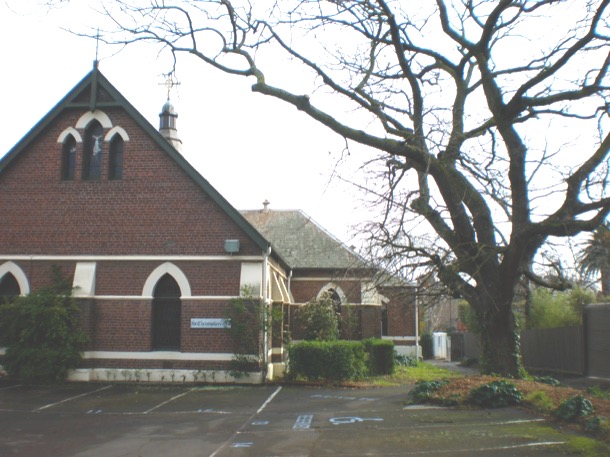
Box Hill Gasworks is now gone, but it was an important part of our parents' history. It was built early in the history of Box Hill:
7/1/1890 The Argus
Some twelve months ago the Nunawading and Boroondara councils granted permission to Mr. Thomas Coates, hydraulic engineer, to lay down gas mains in the streets of the two shires. Mr. Coates purchased an eligible site near Elgar road, Box Hill, upon which to erect the gasometer and the other necessary buildings. At the present time all the mains have been laid down in the shires named, and Mr. Coates is now in a position to light up Surrey Hills and Box Hill with gas. The local works are of such a nature that Mr. Coates contemplates being able to supply the wants of the district for many years to come without enlarging the gasworks. Last night a trial was made in Box Hill and Surrey Hills, when the corporation lamps were lit with gas for the first time. Illumination works were erected at the intersection of the leading streets. The trial was considered a very favourable one, the gas burning bright and clear. In connection with the lighting of these shires with gas a public banquet will be held in Surrey Hills next Monday night.
Over time three gasometers were built.

We don't know exactly when Jim started work at the Box Hill Gasworks, but in 1945 he left the Maribinong Munitions factory, where he had spent the war years. It was that year when our parents married and Jim moved into his in-laws’ Surrey Hills house. Soon after, he started work at the gas works as an analytical chemist. He worked there until began teaching in 1954.
Sue remembers him riding his bicycle to work, and later, a motorbike.
He worked in the laboratory, doing things like checking the calorific value of the gas.
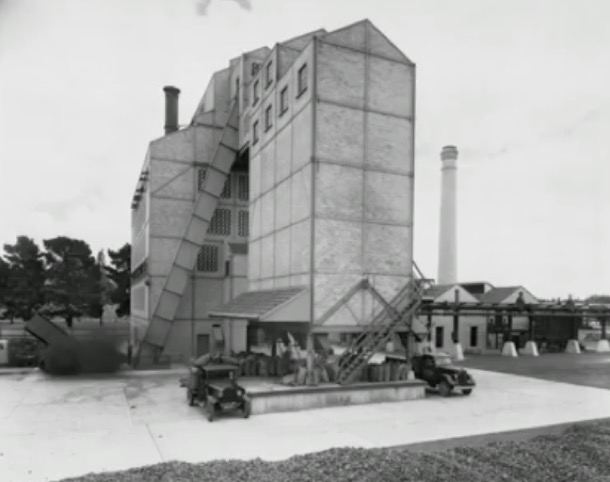

Melbourne’s gas supply was made from Latrobe Valley brown coal, sent by rail to the various gasworks, owned by Colonial Gas Company. Box Hill was one of the biggest. As Melbourne expanded after the war, the demand for gas meant that the various gas works were very busy.
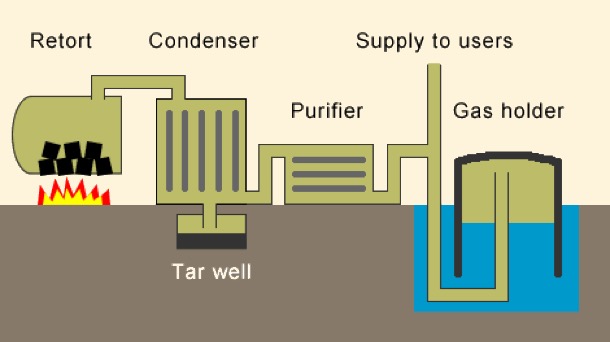
But, by 1960, substantial natural gas reserves had been discovered around Australia. Over the next five years all the Gas plants in Melbourne had closed down, and over 1000 workers were made redundant, by the discovery of natural gas deposit in Bass Strait. Over one million gas appliances in Melbourne were converted to natural gas in 1968. We remember the conversion time. There must have been plenty of publicity. Natural gas has no smell, and, for safety, they put in an additive to make it smell quite strongly. The flame was slightly different, but all the existing burners still worked.
The Gas Works are long gone. Box Hill Institute now occupies the site.
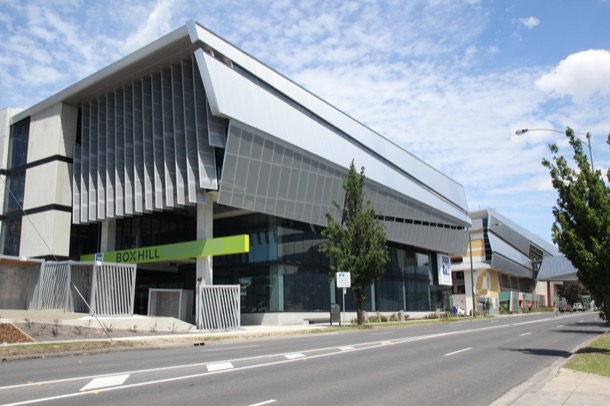
One of the fortnightly highlights in our simple lives was a trip to Box Hill Library. We loved this excursion, as we spent many hours reading on our beds. Books were expensive and we only owned a few. We had to rely on the Library so that we could finish our favourite series like Famous Five and the Billabong Books.It was very exciting if the next book in the series was on the shelf.

This small brick building was opposite the Town Hall at the end of the shopping centre. Whitehorse Road always had a wide, tree lined median strip, as it does today, and the library was right in the middle. It was later replaced by a grand modern library, but the small brick building is still there.
In our childhood, a trip to Box Hill shopping centre was quite an excursion, involving a four mile walk. In 2019 Google Maps says it takes thirty two minutes, but with small legs and a pusher as well, maybe it took a little longer. I remember it was fun and not arduous at all. The route went through suburban streets until Canterbury Road and from there it was ovals and open ground.
Box Hill Brickworks was one of the best sights on the walk to Box Hill, as the brickworks were still in full production. We marvelled at how small the men and carts were at the bottom of the quarry, and watched the procession of carts pass up and down the steep rail track to the actual brick works.
Box Hill Brickworks was founded in 1884 and was one of fifty or so brickworks throughout Melbourne, producing bricks, tiles and pipes for the building boom and ever expanding city. During the working life of the brickworks the clay was extracted from two clay holes or quarries. The first became Surrey Dive which became a popular swimming venue, but off limits to us. Sometimes however, we also gave ourselves the horrors, looking at green, mysterious waters. There were rumours of 'the dive' being bottomless and of swimmers disappearing in its murky depths. One story was of a man who took a very deep dive off the cliff side and simply disappeared. Some time later his body surfaced in Blackburn Lake, five kilometres away. No wonder we looked in awe and horror through the fence.
Today Surrey Dive is an attractive small urban lake used for swimming and remote controlled boat races.. A walking track around the ‘old dive’ and the brick works is planted with indigenous vegetation and a relaxing and attractive area.
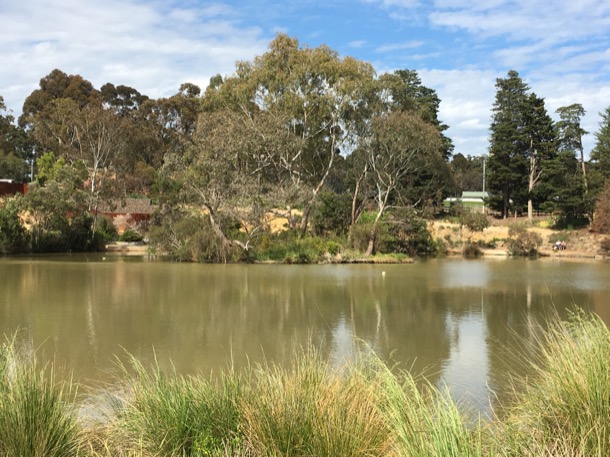
The other clay hole was the quarry that was in operation doing our childhood. It was adjacent to the brickworks and kiln, now derelict but still heritage listed. Unfortunately no restoration work has been carried out. The kiln itself was a massive, red brick building constructed on two levels and, of course, with a huge brick chimney.
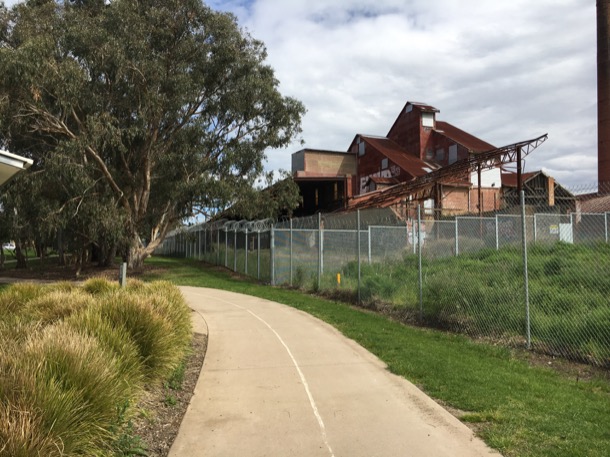
The quarry that was still in full production in our childhood, is now completely filled in. That cavernous hole in the ground is now a large mound covered in every weed known to man. On the horizon above the weeds, are the sky scrapers of twenty-first century Box Hill.
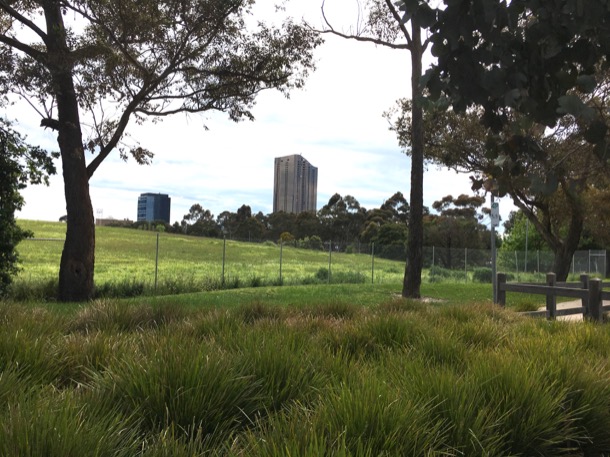
Box Hill shopping centre developed as a commercial centre, as soon as the railway line between Hawthorn and Lilydale was finished in 1862. It became an important transport hub for the eastern suburbs and beyond. During our childhood, Box Hill was the shopping destination for a big purchases. For instance, I can remember choosing a ‘walking’ doll with opening and closing eyes for a birthday present and the excitement of choosing a winter coat with a brown velvet collar. Another favourite shop was the delicatessen where such delicacies as rollmops, sauerkraut and frankfurters could be bought. Amongst the many single fronted small businesses were several large shops such as Taits haberdashery on the corner of Whitehorse Road and Station Street and Maples furniture shop. We also had a Coles variety store that sold anything from socks and singles to cosmetics, and MacEwans Hardware whose slogan was, “You can do it with McEwans because we’ve got a million things.”
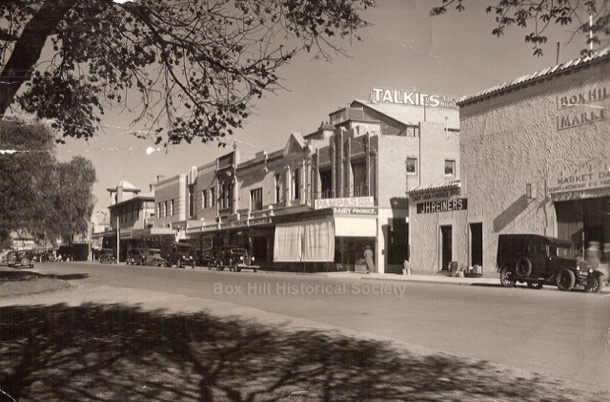
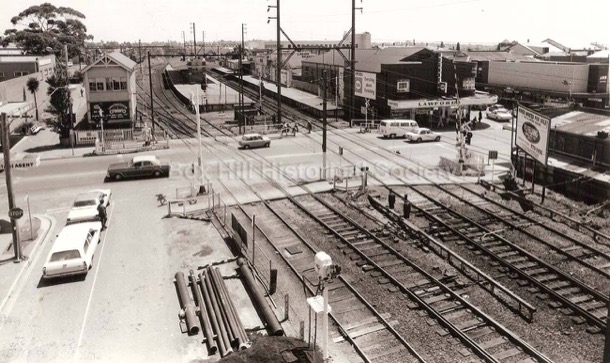
This is a photograph of Box Hill Station and the surrounding shopping precinct in the 1960s. In the centre of the photograph is the old station, that is now underground. Today, above ground, occupying the whole block surrounding the old station, is Box Hill Central and surrounding shopping malls. The signal box, the tall structure on the left of the railway gates is now occupied by the thirty-six storey golden residential tower, called Sky-One.
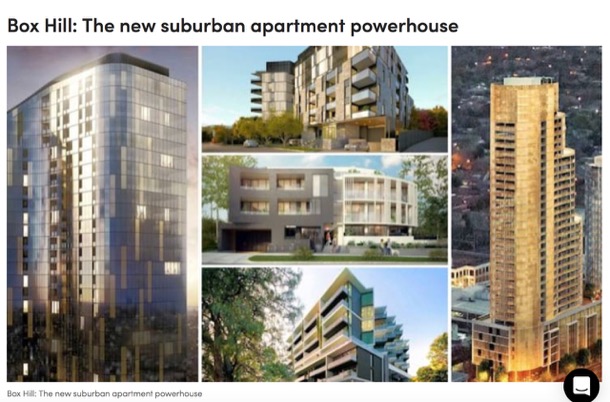
In the twenty-first century, Box Hill, as a commercial centre and transport hub, continues to influence the built environment around it, as you have no doubt witnessed. Officially designated as a development hub, Box Hill now sports high rise office and apartment towers. The streets we once drove down are now shopping malls, the station is underground, the railway gates are long gone and the strip shops have been replaced by a multi storey modern shopping centre. When we were children the shopping crowds were white and Anglo-Saxon. Today they are predominately Asian and the shops and restaurants reflect the change in population.
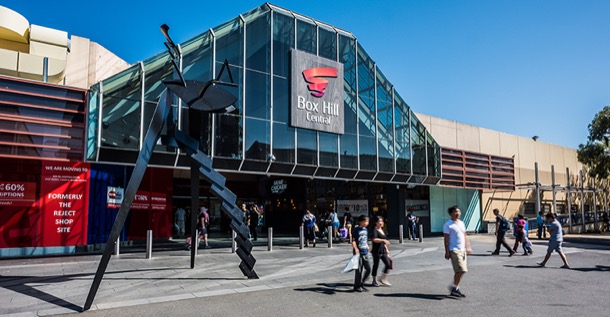
When we, as a family, first started going to the local Presbyterian church, it was called Presbyterian, Wattle Park. We had PWP embroidered on the front of our blue gym uniforms. This was before the advent of the Uniting Church. Church services were held in a cream brick building, called Forsythe Hall.
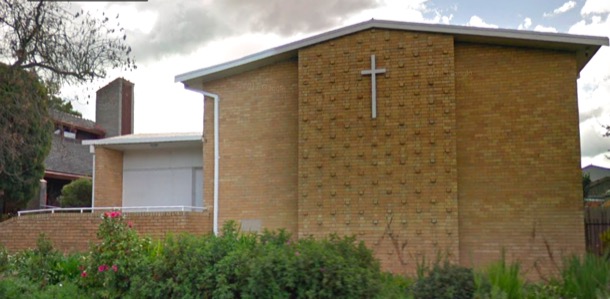
Attached, behind it, was an older little wooden building. During our childhood, this wooden building, Staley Hall, was used for a kindergarten during weekdays. In the evenings, various groups used it, including church boys’ and girls’ clubs (PBA and PGA) and the mixed club (PFA- Presbyterian Fellowship Association), we went to as teenagers. Sue and I both learnt to dance there, and I broke my front teeth on the heater in that room.
We have many memories of Forsyth Hall… dances, performances, Saturday afternoon movies, gym classes and, of course church services.
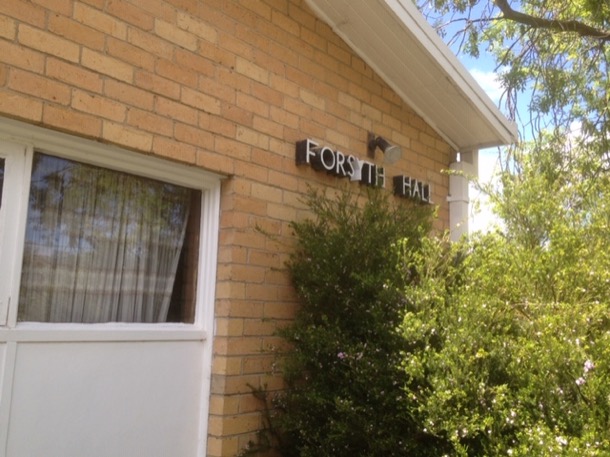
Both our parents were Elders of the church. Our mother taught Sunday School, our father ran the PFA for a while, and was on the board of management. The church was their only real friendship group, and was the only social life we had, as a family.
In the early 1960s the church community began the project of building a new church on the site. The size and scale of the project was a source of much disagreement between our father and others on the management committee.
In the end, a very grand architect designed building was commissioned. The new building was designed by well known architects Chandler & Patrick. An 1887 pipe organ was relocated from a church in Melbourne and extensively rebuilt. The new church, renamed St James, opened in 1965.
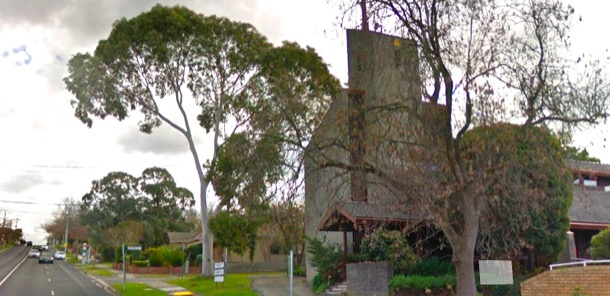
I loved it, because I sang in the church choir, and it had a choir loft at the back and great acoustics.
The buildings are still there. Sue and I visited as a detour on our “back to school” walk in 2016.
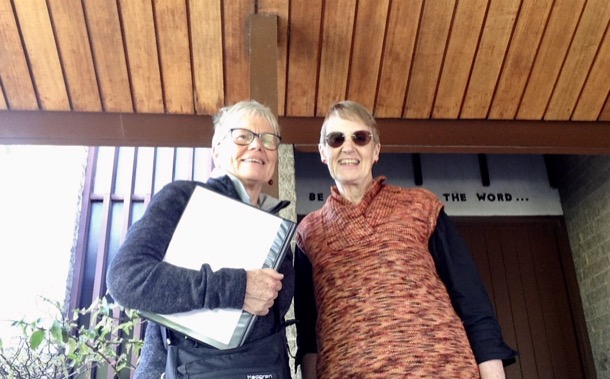
The Built Environment - Hawthorn
These posts can be viewed as a virtual pilgrimage of the structures and buildings in Melbourne and how they relate to our family. Melbourne is undergoing a tumultuous time of change, as, in 2019, its population grows to nearly five million. Our family landmarks are inevitably caught up in the changes too, as you will see.
Our first post covers the suburb of Hawthorn.
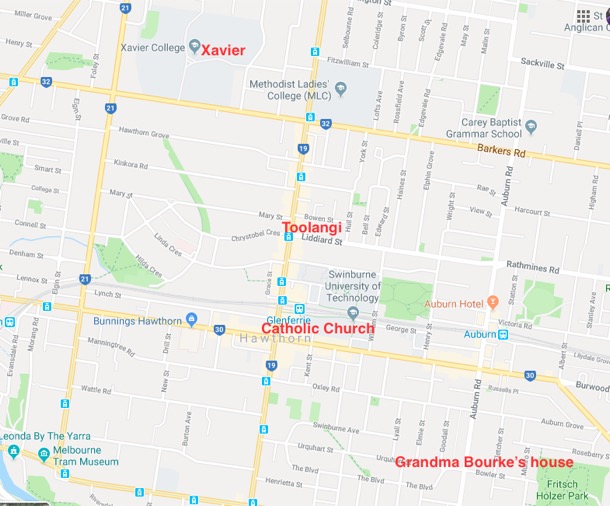
Glenferrie Road
733 Glenferrie Road is listed on the Glenferrie Road Historic walk as the ‘historic mansion Toolangi. It was built in1905 as a doctor's surgery and residence for William Clayton, physician and surgeon.’
This house is significant to our family as two generations of Bourke doctors lived and worked here and our father spent his teenage years here.
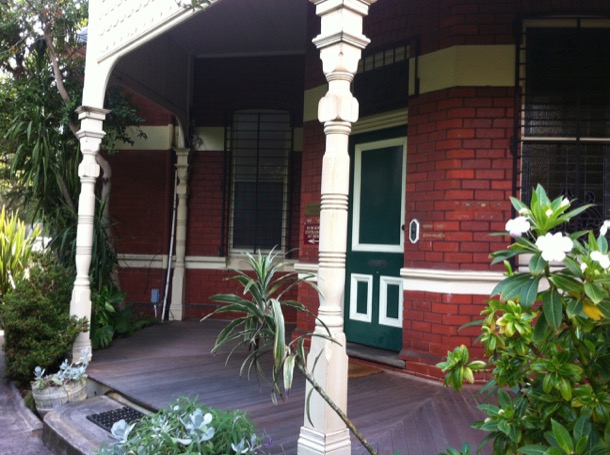
It was in the late 1930s that our paternal grandfather Dr. Hugh Bourke and family moved to Glenferrie Road from Koroit. Presumably Grandfather Bourke bought both the property and the medical practice.
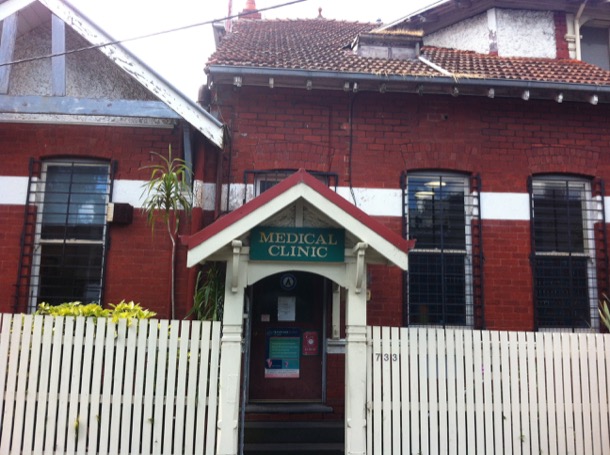
At this time, our father was at secondary school at Xavier, where he had boarded until the move. He continued to live in the Glenferrie Road house until he was married in 1945.
After Grandpa Bourke’s death in 1950, Grandma Bourke moved out and Dad’s brother Jack and his family moved into the house. Jack took over the practice, which he ran until he retired.
I have clear memories of the house, both visiting Uncle Jack and, once or twice, the surgery. The house seemed enormous and imposing, and as we mentioned in a previous post, the paraphernalia of Roman Catholicism was very evident. Uncle Jack also had a greenhouse in the back garden where he grew orchids and Christmas Lilies. The garden shed and the greenhouse where still there until recently.
I still associate the perfume of Christmas Lilies with visits to Grandma Bourke at Christmas.
The building next door to Toolangi was the Hawthorn Motor Garage, built in 1912 . From the 1920s the garage was run by Albert James Kane and family, who had it for 20 to 30 years. They introduced the first electric petrol pump in Hawthorn.

The Hawthorn Motor Garage building is on the Victorian Heritage Register. It is the oldest known purpose-built motor garage in Victoria. Dad would have been very familiar with the Kanes and the garage: while courting our mother, he was lucky enough to be able to borrow his father’s car and use his petrol coupons to fill up at the garage next door. As it was wartime, petrol was strictly rationed but doctors received extra coupons, that Dr. Hugh obviously allowed his son to use.
In April 2019, when we visited it, the site of the house and the garage were in the process of being redeveloped. The garden and out buildings have been cleared away but the main structures of the Hawthorn Motor Garage and Toolangi remain. They will be repurposed as part of the new apartment complex being built on this corner.

At the other end of Glenferrie Road shops is the Catholic Church. An imposing bluestone structure, the Church of the Immaculate Conception still dominates this busy corner. The Bourke family would have attended Mass here every Sunday. Now I walk past here every six weeks on my way to have my hair cut. Time marches on.
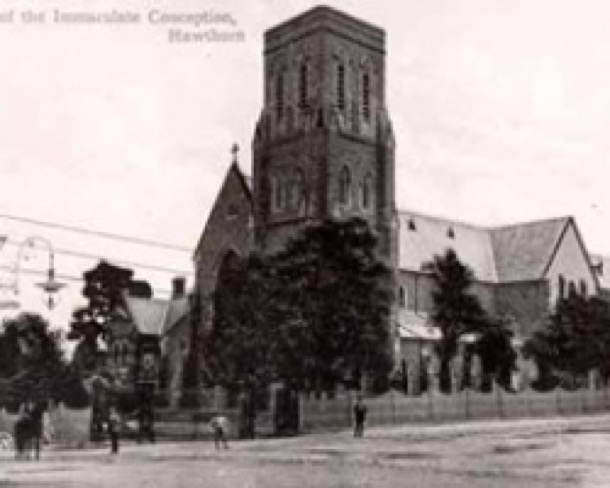
Urquart Street
After our grandfather Hugh’s death in 1950, Grandma Bourke moved a few streets away to Urquhart Street, still in Hawthorn, leaving Jack to bring up his family and run his practice from the Glenferrie Road house.
We remember this house well. Grandma Bourke was a keen gardener whose beautiful roses and bulbs were fertilised by the manure from our parents’ chooks. A huge weeping deciduous tree in the front yard afforded a play area for visiting grandchildren. The house was big enough for our aunt and family, who lived near Warrnambool, to stay over Christmas.
It had a coal cellar, accessed by a trapdoor on the back verandah, with fed the coke heater.
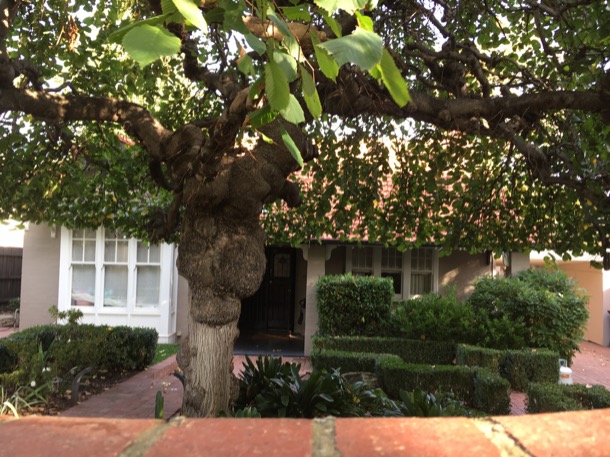
The house looks much the same in 2019, as it did sixty years ago, when Grandma served cake and tea in beautiful china in the front room to her visitors, and mugs of tea with slabs of bread and butter to workmen on the back verandah.
Xavier College
Our uncle and father, first went as borders to Xavier College for their secondary eduction. When our father began there in 1932, Xavier had already been there for fifty years. It was and still is, the premier Catholic Boys private school in Melbourne.
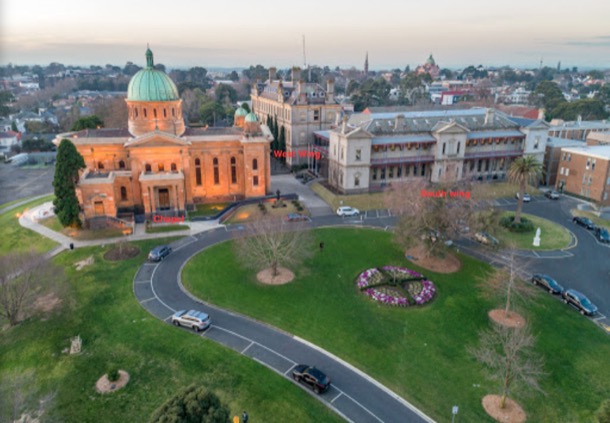
Initially they boarded at the preparatory school, Burke Hall. The buildings of Burke Hall were put together from a trio of mansions on the hill known as Studley Park, some bought by, others bequeathed to, the Jesuits. It first opened, as Xavier College’s junior school in 1921.
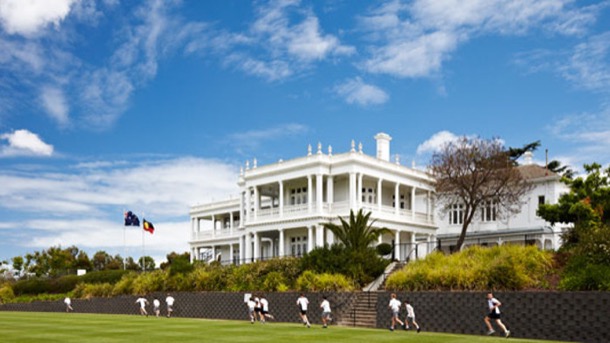
Xavier’s senior School is even older. The South Wing is the original building of Xavier College. The foundations date from 1872, the front dates from the opening of the College in 1878, the back half was completed in 1884. It was listed by the National Trust in 1987.
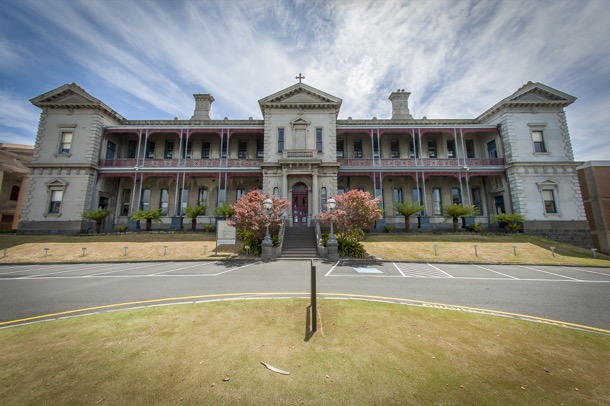
Xavier’s main chapel would have been being built when our father arrived. It was finally completed in 1934. The chapel is a fine building with a huge dome. I have sung in a concert under that dome, and Sue has been in the audience for another concert there.
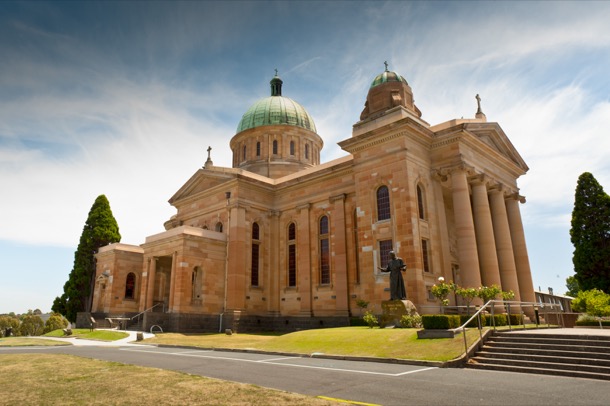
Poowong Footage
In 1976, close to my 25th birthday, Fred and I visited our father and his wife Bev and Bev’s two young sons, Grant and Scott, at their fairly newly acquired property, the old Poowong homestead. Fred, the chronicler of our lives, with his trusty movie camera, recorded the visit on film. Until Fred sent it to me recently, I had not remembered the visit.
The significance of this particular flickering footage of Poowong rests not only on the fact that it is forty years old, not even on the fact that 1976 was during a short window in which we had a fairly normal grown up daughter-father relationship. Its power is much more recent.
Our father died three and a half years after this film was taken in early 1980. He was not even sixty. There was a family history of heart disease, and although, there were occasional bursts of a sunny warm personality, the Jim we had known for most of our lives had been tightly coiled and tense.
As Sue and I watched this footage: our fifty-five year old father walking the paddocks: strong, handsome and happy, clearly happy, I found myself bringing up the possibility of sending this footage to that other family. They had had him for such a short time. We looked at each other in amazement. The process of exploring and exposing our own pasts in this blog, at first staying with emotionally safe pathways, then probing gently the uneven terrain of long disused dark tracks, has led us both to this place. Together we marvelled that our long held animosity and rancour, seemed to have just … dried up.
After getting Fred’s permission, and after a little internet sleuthing, I found a family contact. I sent a tentative paragraph, using Facebook Messenger, together with a link to the film. There was an immediate response.
Bev, still living in that Poowong house, was very appreciative. She said it brought back “lots of great memories”. And apparently lots of us old ladies are good internet sleuths. Bev had been following this blog all along, and she has subsequently sent us some family history booklets and photos.
The family contact I had found was Robyn, wife of Grant, one of those little boys in the film, and Grant has a very special interest in this story. By chance, I had sent the footage to the very person who had found Jim, after he had died. In Grant’s own words:
One of the reasons for our move to Poowong was the poor health of my stepfather. He had suffered a serious heart attack and had been pensioned out of the teaching service, and a less stressful lifestyle was recommended. Sadly for Jim, he would only enjoy the more sedate lifestyle for two years, as he passed away early in 1980.
… Every summer without fail, my family would join with my mother’s sister’s family in a month-long Christmas vacation at our big old (holiday) house. The summer of 1980 was no different except that, at the end of January, Jim and I returned to Poowong to attend to some work around the farm, leaving my mum and younger brother still vacationing at Inverloch.
It was one of those long daylight saving summer days and, towards the evening, Jim set off to search our boundary fence for his tobacco pouch that he had lost during the day. He had been gone for a long time and it was almost dark, so I decided to go for a walk to find him. My dog Butch led me out to the side paddock, and immediately ran to a steep incline covered in long grass, by our fence line. The world today is permeated with death, and even children as young as eleven are far too familiar with its many faces. But for me at eleven years old, death was foreign and the stuff of nightmares. To me at eleven and to me now at 44, it will always be the same - the face of a 58-year-old man drained of blood, sheer white, pale blue eyes staring up into a twilight sky. Jim died of a massive heart attack leaving me alone on the farm, waiting for mum’s ritual telephone call that night.
The details of the chaos of that night and the weeks ahead can be imagined. The trauma inflicted on our family was immeasurable, as anyone who has suffered an unexpected loss would know.
A few months after this, Grant had a life changing experience on the very spot where he had found Jim’s body.
He goes on to write, In the more than 30 years since that experience, I have had much time to reflect on what it means to me. It has given me great comfort at times and has given me an unwavering belief in the hereafter.
Inspired by this, Grant went on to investigate and research the Paranormal, travelling throughout Gippsland, interviewing people and compiling evidence on some of Gippsland’s greatest mysteries. His book, “Great Gippsland Mysteries” was published in 2014.
The Pakenham Bourkes 1939 - 2017 Part Two
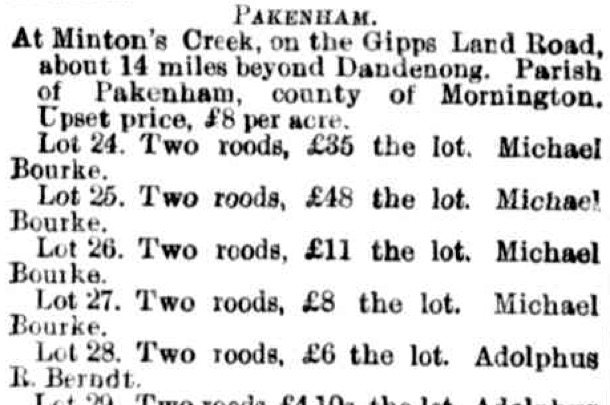
This example and a number of others are parcels of land around Pakenham.
Much of this investment was aimed at establishing their sons on large local properties.
Michael became an important citizen in the very early days of the Pakenham area. He was an inaugural member of the Berwick District Roads Board. Later this Board became the Berwick local council. Three of his sons were to spend time as Berwick Shire councillors, each of them spending time as Shire President. Michael was also post master and a trustee for the church, the school and the local cemetery. There is also record of nine nephews and nieces coming to Australia from Ireland, each receiving the best he could afford.
Michael died in 1977. Catherine took over the business and became quite a force in the district in her own right.
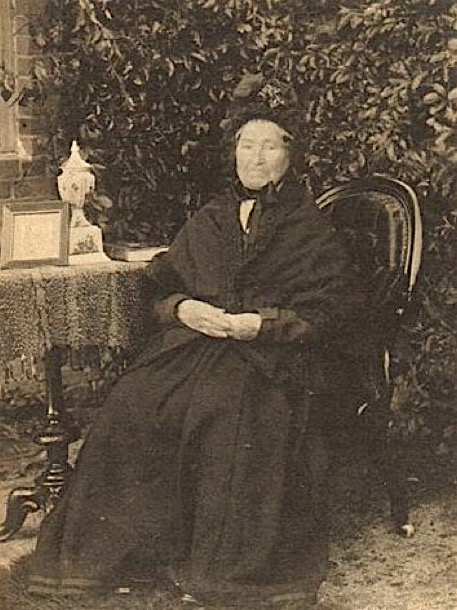
She lived into her nineties, dying in 1910. Her obituary describes her colourful life:
South Bourke and Mornington Journal Wednesday February 2, 1910
It is quite true to say that never in the history of this part of Victoria has the death of anyone been the general subject of so much interest and discussion as that of the late Mrs. Bourke who, with her husband, was one of the first settlers in Pakenham. The deceased lady was married in Ireland to Mr. Michael Bourke in the year 1838, being then 20 years old. Evidently the plans for their future had been prearranged, for the same day they shipped and sailed for Australia, arriving in Melbourne on St. Patrick's Day, 1839. They obtained employment as soon as they landed, managing a dairy farm at Moonee Ponds, where they remained until 1844, when, having saved money,they took up a run under a squatter’s licence on the Toomuc Creek, opposite Grant's orchard, then known as Bourke and Neville's station. There they remained for a number of years, until shortly before Black Thursday Mrs Bourke and her family took possession Bourke's Hotel, at that time known as the "Latrobe Inn," the husband remaining for a time at their station. On Black Thursday the whole district was in a blaze, and whilst Mr Bourke was trying hard to save the station property (water having been exhausted milk was brought into play and ultimately the run saved) word was brought to him that the hotel property at Pakenham was surrounded by fire. Galloping down there he found his wife and her children had saved themselves by crouching in the water in the bed of the creek. This is only one of many thrilling incidents in their lives.From the time they first arrived in this district to the time of Mr Bourke’s death in 1877, as they made money, they at once invested in land. Banks were unknown this side of Melbourne in those days, and their investments invariably turning out profitable, they slowly but surely acquired wealth. The name of Bourke and Bourke's Hotel will be, for generations to come, remembered as the pioneers and landmark of this part of Gippsland. The lives of Mr and Mrs Bourke have clearly proved what thrift, hard work and stout hearts can do in the settlement of this country, for at the time they arrived, the country was full of blacks camps along the banks of Toomuc Creek, and the country dense bush mostly. Yet out of all this Mr Bourke. made a fortune, buying up land as far away as Dandenong, and settling his sons on the land.
After his death Mrs Bourke continued to carry on and work hard, when there was no call for it, on the hotel property, and, as she repeatedly told the writer of this, she had more than her reward in the welfare and prosperity of her family, and she was proud of them, and well she might be, for her three surviving sons, Thomas, Daniel and David, have all been presidents of the Berwick Shire council, and all hold His Majesty's commission as Justices of the Peace, whilst the daughters are comfortably settled and highly respected. One of one of them, Miss Cissy Bourke has been (and still holds the position) of post mistress at Pakenham since a post office was first created.
With daughters like these, and sons holding the high positions they do, ever ready to give of their time and money in advancing the interest of the township and district, Mrs Bourke. has gone to her rest feeling fully rewarded for the years of her life devoted to and spent for their good. It would be difficult to find in the history of Australia, a parallel case of a man and a woman rising from the humblest rank of worker leaving behind them such a fortune and family so respected.
Mrs Bourke was probably the oldest colonist living at time of her death, having attained the ripe age of 91 years, being a colonist for 71 years and having resided at Pakenham for the last 67 years. She is said to have never, had a day's serious illness, and death was hastened by the severe heat three weeks ago.
Mrs. Bourke who died, on the 24th January at 9 in the morning, was-interred in the Pakenham cemetery on the 26th. A solemn Requiem High Mass was held in St. Patrick's Church from 10 to 12 a.m., the coffin being heavily draped in mourning, thronged with relatives and friends of the deceased. At the close of the Mass, the coffin was carried to the hearse and proceeded to the cemetery, a procession of carriages and horsemen fully half a mile in length and composed of people of all creeds following, and so was laid in her last resting place with sorrow and with respect: a good mother, a kind hearted woman, and a true colonist.
Michael and Catherine had fifteen children in total. Here in birth order is what we know of each of them:
James, born 1839, at Moonee Ponds. He was married twice: first to Johanna Conway in 1867, and secondly to Margaret Cahill in 1877. He had ten children all together, all girls. James’s property was in Dandenong, near the corner of Dandenong Road and the M1 freeway. He died in 1892 and is buried at Pakenham Cemetery.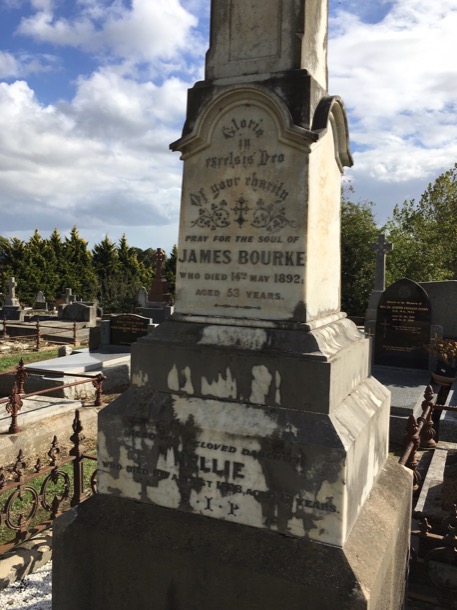
John was also born at Moonee Ponds, in 1840. He married Mary O’Neill in 1877. John and Mary lost their fist two children in infancy, but went on to have another five. The family settled in Leawood Park Rosedale, a long way from Pakenham. Today, Leawood is an Angus stud farm which has been in the same family, the Stuckeys, since 1944. It is a covenanted Trust For Nature property, protecting 18 hectares of important floodplain habitat along the Latrobe River. 
John died in 1892, He is not buried in the Rosedale cemetery, but his son John who died aged 4, a year before John senior died, is there. Mary went on to live until 1935.
Thomas was Michael and Catherine’s third son, also born at Moonee Ponds, in 1842. In 1875, Thomas married Jane Smith, daughter of another family who came from Shanagolden in Ireland, and settled in the Toomuc Valley. The Smiths probably travelled from Ireland on the same ship as Thomas’ parents.
Thomas and Jane moved to the property “Snowview”, which Thomas had “selected” some time earlier. They had four children. Thomas, like his father, was very prominent in local politics, serving on the Berwick Shire Council for forty-five years. During most of that time he went on horseback from his home at "Snowview" to attend the meetings at Berwick, and it was only through advancing age that he finally resigned from the council. He lived at “Snowview” right up to his death in 1929. It is now a heritage listed property, which remains in family hands to this day.
Thomas and family:
Mary Ann was born a year later, in 1843 the last to be born at Moonee Ponds. Mary died aged six. We know very little about this Mary, we don”t even now where she was buried. The family was living at Minton’s Run when she died, perhaps she was buried near the slab hut they lived in. The Pakenham cemetery wasn’t formally gazetted until 1865, though, reportedly, there were burials there before then. A devastating fire in 1944 burned most of the wooden grave markers in the cemetery anyway, so much of the historical graves are now unmarked.
The fifth child is Michael, born in the slab hut at Minton’s Run in 1844. Unlike the other sons, Michael did not take up life on the land, but became a lawyer. He married Ellen (Nellie) Doogan in 1884. Nellie was the daughter of Pyalong publican, Hugh Doogan. The family lived in Parkville, near the city of Melbourne. Michael and Nellie had six children, the second of whom, Hugh, was our grandfather.
Michael died in !908 and is buried with Nellie and their third son Austin, in the Kew cemetery.
Michael and Nellie's Parkville house: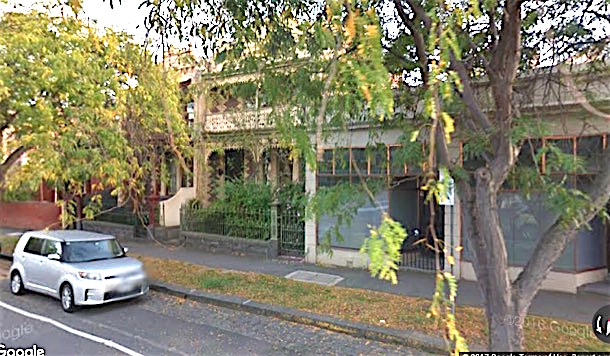
Michael and Nellie's grave: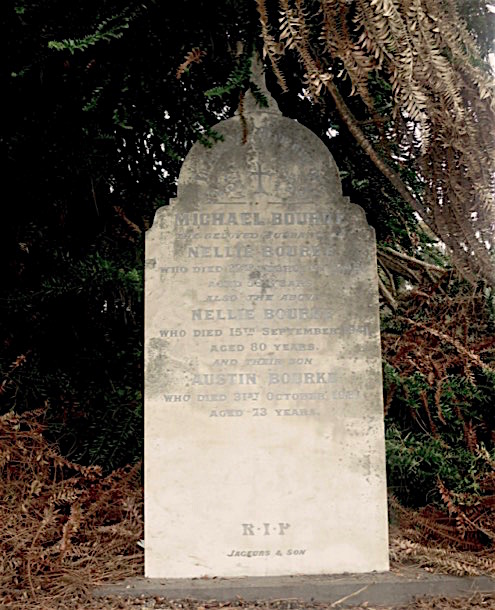
Catherine is the sixth child. She was born in 1845 at Minton’s run. She married Charles Billings in 1878. They lived in Prahran, in a house named “Pakenham”. It seems to have been an important family place, with births marriages and deaths all occurring there. Charles and Catherine had seven children and Catherine died in 1929, and is buried in the St Kilda cemetery with her sister Mary Lucy.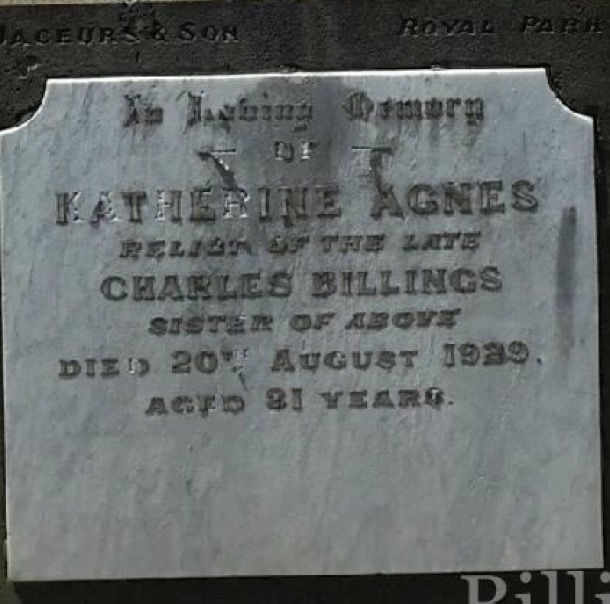
Daniel Bourke, was born in 1847. He was Michael and Catherine’s fifth son, Upon retirement from the Berwick Council, he is quoted as saying, “Our nation was not built on bloodshed, but on hard work”.
Daniel, like almost all of his brothers lived out this ethos on the land. Michael and Catherine seem to have imbued their children with the desire to do well, serve their community and ensure that their own children were also settled well. Daniel followed the family line. He married Fanny Levers who produced eight children and pre-deceased Daniel by only three years.
Daniel’s early years were spent in Pakenham where he owned Mt Bourke, some 400 acres, sold off from a larger property owned by the Hentys. This property is now in central suburban Pakenham, as we mentioned in the previous post. The heritage listed house was built one year after Daniel sold the property, probably by the new owners. David also owned the Gembrook Hotel in Pakenham.
What is notable about this article is that it also includes Catherine’s application for Bourke’s hotel, and Daniel’s brother Thomas, is the licensing magistrate!
It is Daniel’s public life in Pakenham that gives us some idea of the man. Daniel served on the Berwick Council for twenty years and it is the speeches from his farewell dinner that offer these insights. Fellow councillors were obviously very sorry to lose his services, as they commented that,
‘…his name will be remembered in Pakenham with pride and honour..’
‘Berwick Shire is losing on of its leaders.’
‘He was one of the largest-hearted men in the district….’
‘His calm, cool, warm-hearted manner won him friends from all ranks. He was in the full sense of the word a reliable man and a gentleman.’
Daniel held many other other positions the community, as President of many clubs, farming organisations, and was also regarded as a pillar of his Church and well regarded by others…’
Daniel’s own speech in reply to all these accolades is also revealing. In reply he says that it was the noblest duty of a man to help his neighbour and the magnificent national feeling that was through gathering particularly pleased him. Australia to him was the greatest country in the world.
This offers an insight into Daniel’s character but also to the ethos that appears to run through the family, and no doubt contributed to their success.
Daniel and his family moved to Stratford where he and David, his younger brother of Monomeith fame, owned another property, ‘llowalong’. Daniel and his and wife felt that there was not enough ‘scope’ for their sons in the district and it was for their sake they were leaving Pakenham. Daniel died at the ripe old age of 88 leaving one of his sons possibly James on the Stratford property.
Mary Lucy was probably the last child to be born at Minton’s Run. There are doubts about the date of her birth. Mary Ann had recently died, and this Mary was perhaps given her name. She died, unmarried and is buried in the St Kilda cemetery. On her grave it says she was aged 37, but this would make her born the same year as her namesake Mary Ann. Had she lied about her age? Is the information about the two Marys wrong, and they are the same person? We don’t have a grave for Mary Ann, so there are unanswered questions about these two. The fact that Catherine was buried in the same grave as Mary Lucy, and near to Prahran, when Catherine lived suggests that the two were close. Perhaps unmarried Mary lived with Catherine and Charles.
Ellen was the first child to be born at Bourke’s hotel right in Pakenham. She was born in 1851, the year of the big fire that burned the Minton’s Run property. She married John Augustus McKeone, of Port Albert Victoria. The couple lived at times in Beechworth and in Narrandera. They had a total of nine children. John died in 1895 and Ellen in 1934.
Milo was born in 1852. He never married. He died aged only 25, “after a short illness” at the home of his older sister Catherine, and is buried in the Pakenham cemetery.
Michael and Catherine’s youngest son David, was born in 1856. He married Mary Hunt in 1888. David had bought Monomeith Station in the mid 1800’s. It was originally 3000 acres comprising what is now the area of Monomeith and Caldermeade.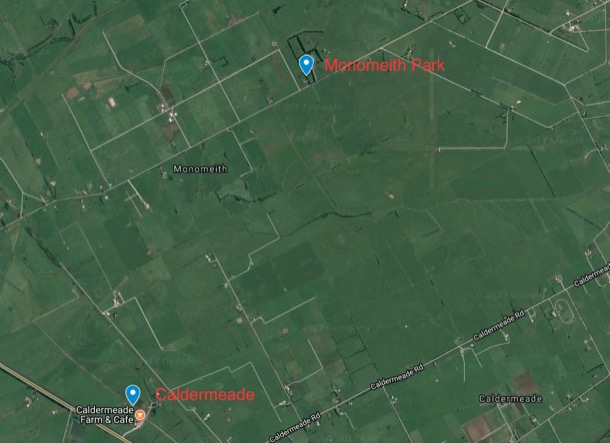
On the map you can see the World War two airstrip, south east of Monomeith Park. It was constructed as a RAAF fighter base to protect Yallourn where all of Melbourne’s power came from. In the end they only built two gravel strips, in the shape of a cross.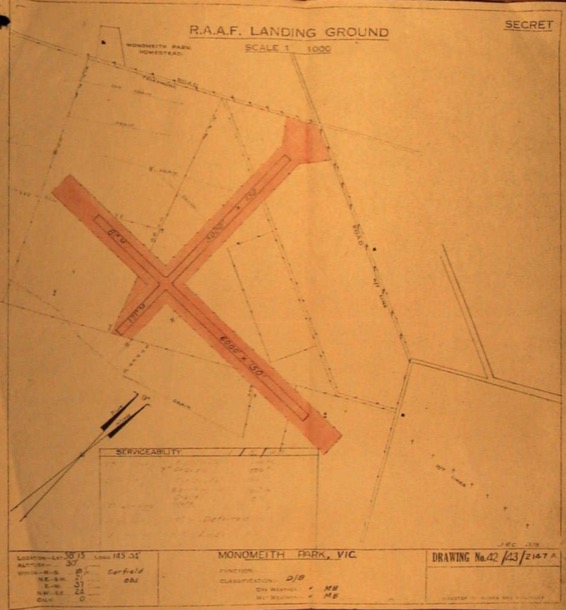
It was fine grazing land on black loam country and is part of the rich history of the early settlement of the area. Over the years hundreds of prime bullocks were driven to Newmarket sale yards in large mobs. According to local legend this feat was undertaken by the well-known character “little” Billy Matthews who reputedly drove the Monomeith mob all the way by himself.
In 1886 1000 acres of Monomeith was sold at auction, probably the swampy section. The carrying capacity of the land retained is referred to in, “Memoirs of a Stockman” by Harry Worthington Peck:
“However, the Bourke brothers [David’s sons, Michael and Hugh] at Old Monomeith Homestead of some 2000 acres have today the pick of the estate carrying some 3000 cattle of mixed ages and all fattening. This is probably a record for the Commonwealth and proves the virtue of top-dressing even on the richest natural pastures”
The Cattle King, Sir Sidney Kidman, visited Monomeith for both business and pleasure, another indication of how well known this property was.
In later years the property was again subdivided presumably between David’s two sons Michael and Hugh. Their descendants retained ownership until recently. Ironically after so many years in family hands, through three generations, we have discovered both the properties in advertisements in the real estate section of the Weekly Times.
Caldermeade was sold in 2016.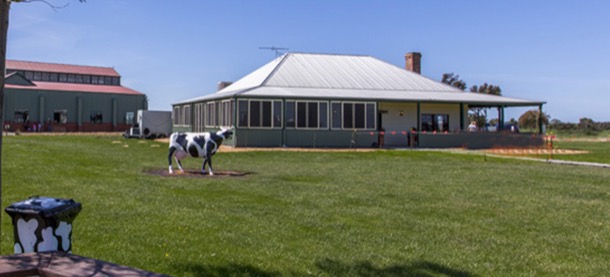
Through articles and advertisements for the property, in the local paper, we discovered more family history. For instance, only four years ago, there was an article in the Pakenham Gazette about Brian Bourke, the then owner of Caldermeade.
A fall from a horse, broken bones and 32 hours lying in a paddock would spell disaster for most 77-year- olds, but Hughie Bourke comes from tough stock. Fearing the worst, family and friends rallied together last week to rescue the stricken grandfather after he was reported missing last Thursday. Now recovering in The Alfred hospital with a shattered femur and pelvis, Hughie reckons he spent his marathon ordeal enjoying the company of animals on his Caldermeade property, but was disappointed to miss the day’s horse racing. Falling from his horse, he remained injured on the ground for almost a day and a half, watching the changing sky and surrounded by foxes and cattle. And while “the old cockie” has a long road to recovery ahead, he told his kids that it was a “bloody beaut” watching the clouds go down and sleeping next to the animals on his farm.”
Monomeith is on the market at the time of this post, July 2017, thus ending three generations of Bourkes running cattle on this property. An article published in the Pakenham Gazette describes the property:
‘Monomeith is heritage listed by the Shire of Cardinia because the house, which was built about 1899, and trees represent a long-term farming enterprise carried out by one family.
The old woolshed, and early picket fences and gateways that survive along the frontage and in some of the paddocks are a reminder of times gone by.
The large double-fronted weatherboard verandah farm house has been home to the Bourke family for more than a century.’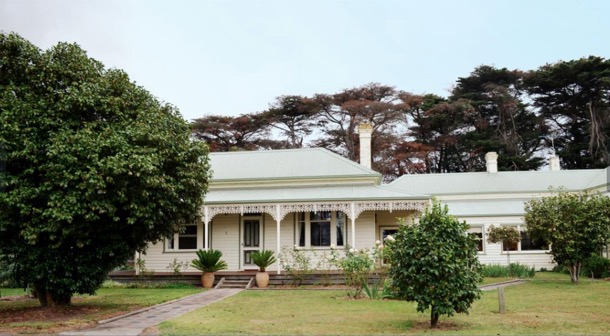
Margaret was the twelfth child of Michael and Catherine. We do not know the exact date of her birth but we know she married Robert Massey Coote in 1883. In 1886, in partnership with Lance Herbert the Cootes established a store and transport business in Orbost. They had three children. Robert died in 1891, and Margaret in 1935.
Agnes’ birth date is also unknown, but we know a little about her life. She married George Fraser of Aberdeen, Scotland. The family lived first in Nar Nar Goon and then in Aukland, New Zealand. They had six children, three born in Australia, and three in New Zealand.
Richard is the next child, but he died in infancy
Cecelia (Cissy) was Michael and Catherine’s fifteenth and youngest child. She never married.
The original Pakenham Post Office opened on 1 February 1859, with Michael as the postmaster. Catherine took over when Michael died in 1877, and Cissy took over from her, serving for many years. The history of Pakenham Post Offices is a bit garbled because, once the railway station opened, in 1977, there were two. Post Mistress was an important official role. For instance Cecelia’s name appears in 1909in the official Federal Gazette as the Electoral Registrar for Pakenham.
THE BOURKES : A RACING DYNASTY
From the early days at Bourke's hotel, Michael showed an interest in horse racing. We have no idea if this interest arose in the colony, where impromptu race meetings were common, or whether the interest came with him from Ireland. As Ireland has such a long and rich history of horse racing, this is quite likely.
Records show, that Michael and Catherine lent the paddock behind their hotel for the first race day picnics at Pakenham. This area was later named Racecourse Road. With great enthusiasm and involvement from Michael and his sons, racing flourished and in 1875 the Pakenham Racing Club was formed. Michael’s sons continued the family involvement, guiding the development of the club after Michael’s death in 1877.
Our direct descendant Michael, fourth son, left Pakenham for a law career in Melbourne. The rest of the family that remained in Pakenham continued to build a racing legacy.
David Bourke, the youngest son and owner of Monomeith Park, was a particularly good horseman and it is his line that continued the public involvement in racing through to the present day. David helped the Club to prosper in the early days, making his back paddock available for race meetings. This area was later named Racecourse Road, and was the site of the Pakenham Racing Club until 2014.
In the 1900’s the club fell into semi obscurity.and the Bourkes once more became involved in response to:
‘a letter from a local policeman to the Chief Secretary’s Office prompted an official letter being sent to the Pakenham Secretary Mr. A. L. Fairburn, requesting action be taken to rectify the situation.’
Hugh and Michael Bourke, David’s sons, came to the rescue, raising 4,000 pounds to reconstruct the course. The course was seven furlongs, 54ft. (1424m) in circumference.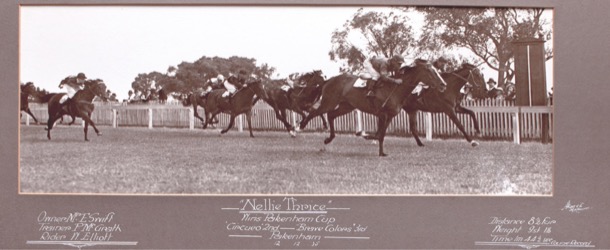
After David’s death it was his sons Hugh and Michael who played the crucial role of keeping the club alive and it continued to hold picnic race meetings. The land was leased to the club by the Bourkes for no fee on condition that profits were spent on public amenities.Finally despite pressure for the site to become Crown land,the Bourkes agreed to sell the track to the Pakenham Racing Club for 25 000 pounds ($50 000). The deal was finalised in 1957.
"It was about a quarter of what it was worth,but back then our family wanted it to stay a racetrack forever and we always thought it would, " Hughie Bourke is quoted as saying.
The Bourkes maintained their interest in the club after the sale, serving on the committee and fulfilling other roles. Michael, David and Gavan held the position of Secretary between the years 1926 and 1999. A number of other family members also served on the committee for lengthy periods of time.
Early this century as the suburban sprawl reached Pakenham the racing club committee decided to sell the land and use the considerable profits to redevelop a new racing track at Tynong on a site of 246 hectares. In February 2014 the cub hosted the last race meeting at the old site and at the time, Gavan Bourke commented that it was sad that the old track,on a 27 hectare site had been sold for redevelopment to accomodate the urban sprawl.
The Bourke family interest in racing is also evident in positions held within the Victorian Racing Club [VRC] by David’s direct descendants.
David Bourke [1930-2005] David’s grandson, was a racing administrator for 60 years. He began his career after his father’s death when aged 19 he took over as Secretary of the Pakenham Racing Club.
He served on the VRC committee for twenty years, seven years, as Chairman. In this role he presided over the nation's most famous race, the Melbourne Cup from 1991 until 1998. The David Bourke Provincial Plate is run annually in June at Flemington, the Saturday of the Queen's Birthday weekend.
David’s brother John, also had a career in the thoroughbred racing industry. He was employed by the VRC as the Veterinary Steward. During a long and distinguished career he was instrumental in the introduction of drug testing of thoroughbreds. Dr Bourke went on to become a world authority on equine medicine and the use and effect of drugs on horses.
So from the first race meeting in Pakenham, in the early days of the Colony of Victoria, Michael’s and Catherine’s descendants have been involved in the horse racing industry. Some, such as our line, have had a recreational interest in horse racing whereas others, such as David’s line, produced several Bourkes who made their careers in thoroughbred racing. Quite a family affair through the generations!
Pakenham, the visit

So, in May 2017, one hundred and seventy-three years after our great, great, grandparents Catherine and Michael Bourke selected Minton’s Creek Run, we stood on the very spot. In 1844 the area was probably grassy woodland, open country, well grassed and with shade for the cattle. Like in so much of Victoria, the early settlers, our great, great grandparents amongst them, could just take possession and let their stock loose. Today the area is still a pastoral landscape but obviously broken into smaller holdings. Minton’s Run appears to be quite hilly, rising from the creek to the foothills of the Dandenong Ranges in the North, and undulating to hilly country in the East and the West.
It must have been a hard life. The day we were there was cold, and after recent rain the ground was soft and muddy. Not much fun carrying water from the creek in this weather. Presumably Michael and Catherine’s bark hut would have been near this water source but up on the hill a little, safe from floods and away from the soggy creek flats. We walked a little way along the dirt road imagining Michael and Catherine building their bark hut, collecting water from the creek and tending their stock.
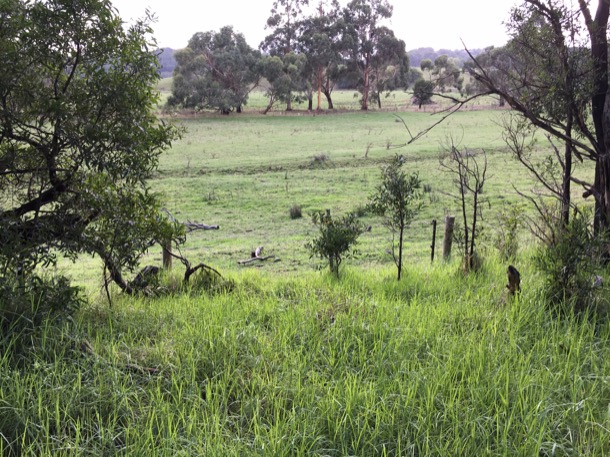
Turning south, we drove to Pakenham on the Toomuc Valley Road. It would have been an easy, flat, gallop downhill to the hotel site on the corner of what was, and still is, the point where the Princess Highway crosses the Toomuc Creek.
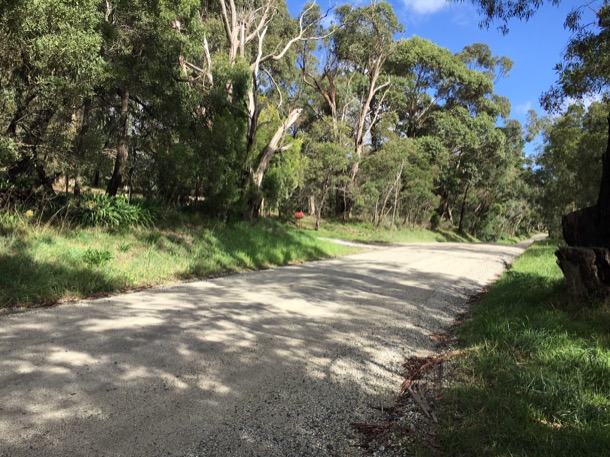
Not so easy for Michael, the day he galloped this way to rescue his family during the 1851 bushfires. Parking opposite the hotel, we walked the short distance to the creek, quite a substantial one, especially after rain. This is the spot where Catherine and the children sheltered from the flames, and where Michael found them safe and sound.
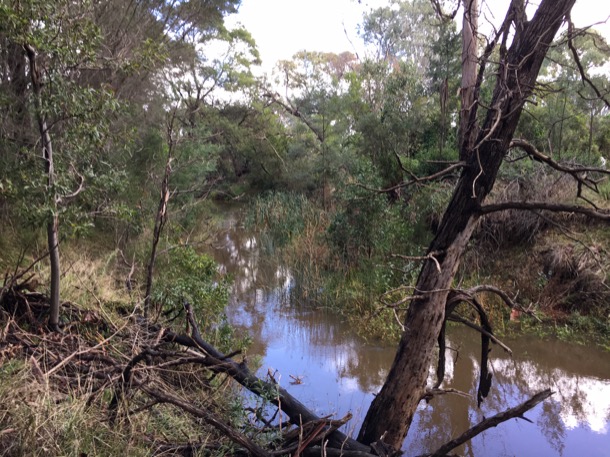
From this side of the road the heritage-listed original chimney is clearly visible. The hotel is undergoing yet another extension and renovation but the old bricks are just visible at the corner of the chimney where the layers applied over the years are crumbling away. Today the hotel is an ugly pile of add-ons and extensions including prominent Thirsty Camel drive through bottle shop. The chimney lives on, as does the business, obviously still thriving.
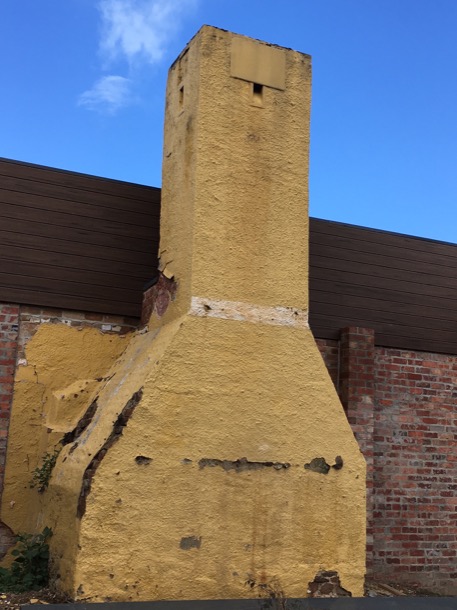
What next? As Pakenham Cemetery was nearby, we thought it fitting that we see where our great, great grandparents were buried. The cemetery is on a hill above the highway which was the main road to Gippsland, back when Michael and Catherine offered a stopping place to travellers. Nowadays, though still busy, and still called the Princes Highway, it is bypassed by the Princes Freeway.
We had seen a picture of Michael and Catherine’s grave, and so had seen the shape of the cross on the top, but the picture had not shown where it was, nor had we been able to read the writing.
It’s not a very large cemetery and soon we found an area with various recognisable Bourke names.
We should have known just to walk to the highest spot! There was the patriarch towering above everyone else.
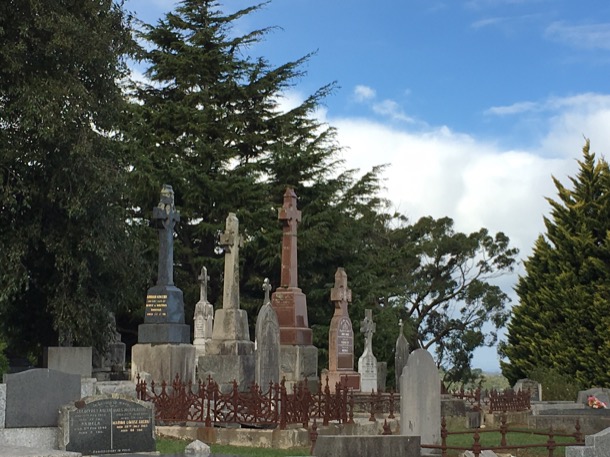
Michael and Catherine's grave:
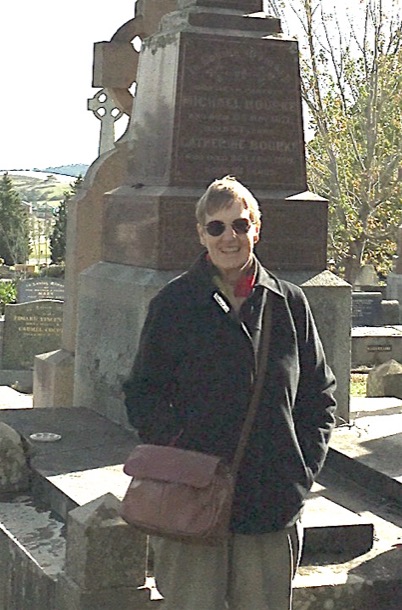
Here is the original newspaper article about Michael’s death in 1877:
We regret to chronicle the death of Mr. Michael Bourke, the oldest inhabitant, as we understand, of Pakenham, whose remains were laid in the Pakenham Cemetery on Wednesday last. His death was accelerated by an accident, which, although it might have had but little effect on a younger man, hastened his end. A few days before his death he had gone up to the hay-loft of his stable to pull down some hay, and in descending the ladder missed his hold and fell heavily on the side of his head. At first it was not considered that be was much injured, but continued to get worse until be died. Although it rained almost incessantly during Wednesday the funeral was a very .large one, comprising most of the old residents for many miles around, by whom deceased was generally esteemed. About three o'clock the cortege started, the body being conveyed in a splendid hearse, followed by vehicles containing deceased's wife, daughters, and other female relations, his sons following; after whom came a number of vehicles, and, lastly a very long array of horsemen. The funeral service was conducted by Mr. D. J. Ahern, of Dandenong, in an effective manner, although during the ceremony the rain was falling very heavily. - From a first visit to the Pakenham Cemetery we cannot say much in praise; of the residents who permit it to remain in its present state so long. There are only five acres of it, which were granted by Government, and it is not creditable to the, residents to allow it to remain almost in its natural state.
The cemetery was very well kept on the day of our visit, and is clearly still in use today. We saw many names we recognised, such as James, Michael and Catherine’s eldest and his daughter Nellie, who had died, aged 17. We noted that four of Nellie’s uncles carried the coffin, including our great grandfather Michael, by then living in Melbourne.
Here is a list of all the Bourkes buried in the Pakenham Cemetery:
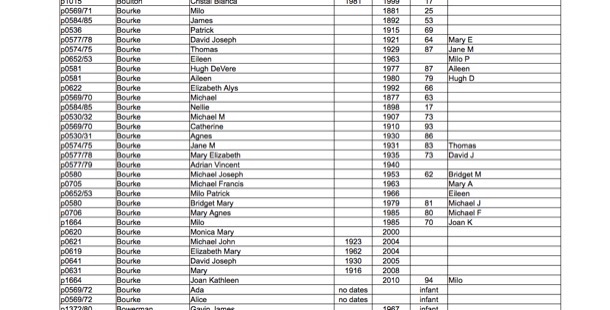
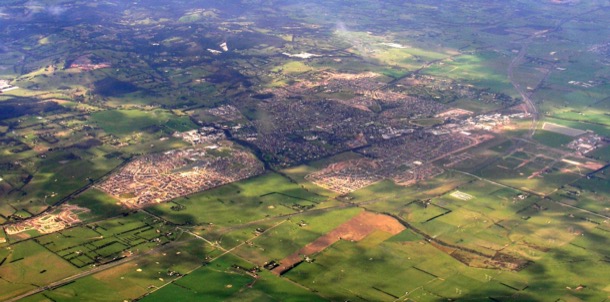
Looking down on the sprawling suburban growth that is now modern day Pakenham we could just see where another piece of Bourke history still stands, Bourke House. We drove down and pulled off the busy feeder road to the freeway into what will become the gateway to a new housing estate. It will eventually swallow the last vestiges of the first Pakenham Racing Club track that the Bourkes were instrumental in setting up. Today the track still visible surrounded by mud, trucks and cyclone fencing. Margaret and I approached Bourke House, right next door.
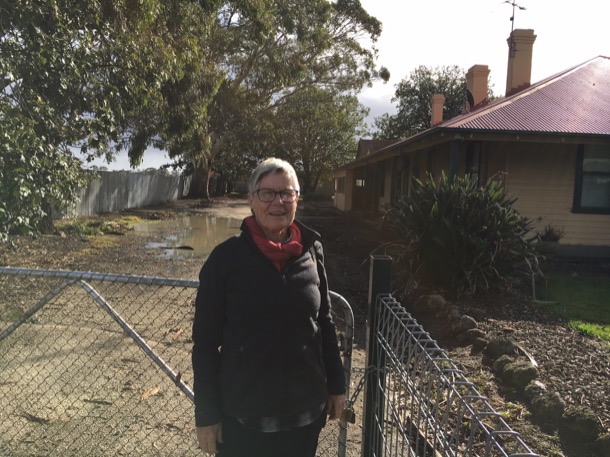
This racecourse residence and stable complex is heritage listed as it is a large, successfully designed and well-preserved residential complex from the 1920s, linked with a private racecourse and associated with notable district figures, such as the Bourkes, prominent Pakenham graziers and horse racing identities. Through its associations with the Bourke family who have played major roles within the Victorian Racing Club, and with the Pakenham Racing Club, this property has been significant in the history of racing in the shire.
The house and stables now sit behind a locked gate next to the sea of mud that was its racetrack. Hopefully when the housing estate is complete the house will also be tidied up and put to use again.
As we sat in the car, map in hand, we realised that, within walking distance of Bourke House, were several significant Bourke properties: the Bourke’s Hotel, the youngest son, David’s first property Homegarth, and the fifth son, Daniel Bourke’s Koo Man Goo Nong which he changed to Mt Bourke.
Homegarth and Mt Bourke have been absorbed into suburban Pakenham. Homegarth no longer exists, but the reminder of its existence is in the name of a playground and Childcare Centre nearby.
Mt Bourke is now a housing estate.
We drove and walked around the housing estate looking for acknowledgement of the history of the area, or directions to the original house. We found none and presumed that the house had been destroyed in the name of progress. But no, on the way home we were enlightened, at, of all places, the ‘Olivers' fast food outlet on the Monash Freeway. Collision of two worlds: as the chatty young lady passed us the coffee and egg sandwiches, she told us that she lived in that very estate, and yes, the house still stands at the top of the hill. Now the house looks down at the closely packed phoney heritage houses and other trappings such as Stockyards Playground, instead of productive fertile creek flats.
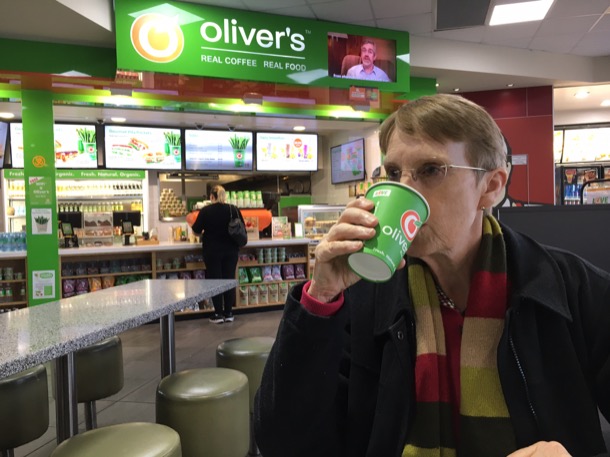
Koo Man Choo Nong/Mt Bourke:
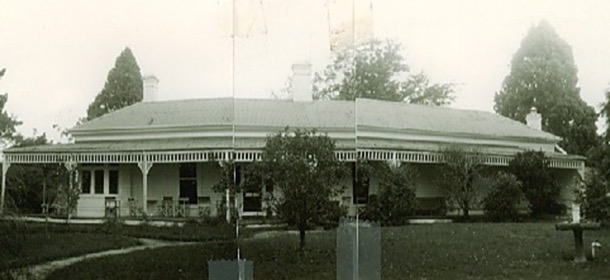
A little further out of town we found Snowview, owned by Thomas, Michael and Catherine’s third son. We could just see the ranges through the drizzle, a wonderful view. No wonder Thomas called his property Snowview. Still in family hands, Snowview is now an equestrian property. It stands at the corner of Bourke Road and Five Mile Road, and is bordered by very, very old, gnarled cypresses. Maybe Thomas planted these as a wind break from cold winds from the ranges?
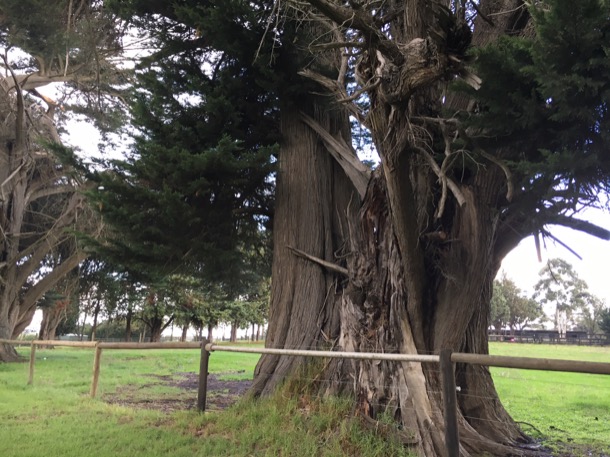
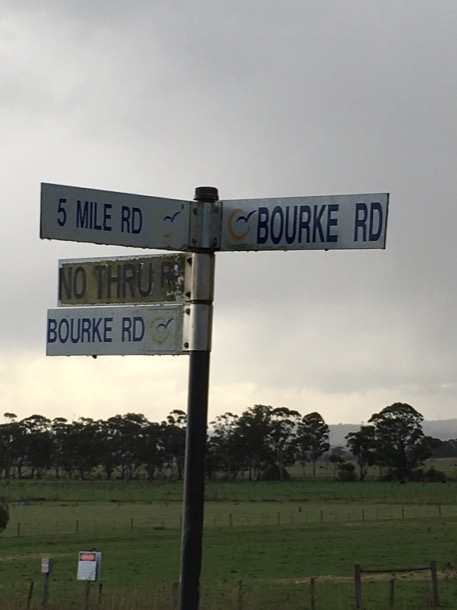
It was getting late but we decided to attempt to find Monomeith, originally owned by David, the youngest son. Monomeith, still on the map, is situated on rich farming land at Nar Nar Goon. The roads were busy with trucks and commuters, very unpleasant driving conditions in the rain, but we soldiered on through several wrong turns, until we decided also to head for home. We now know, after further research, that we were very close. An excuse to go back another day.
The Pakenham Bourkes 1839 - 2017 Part One.
New South Wales had been settled as a convict colony in 1788, when the first fleet arrived. Over the next fifty years, many convicts were transported there, and many English free settlers chose to try their luck in that distant land. By the 1830s, there was clearly a need for more immigrants in the colony. Not only was there three men to every woman, but the balance of convicts to free settlers was all out of whack. There were not enough reliable trustworthy labourers to work on all the properties that had been developed, especially all the sheep stations.
A committee was set up to address this issue. It looked like a win-win situation with England, where the population had outgrown the jobs available, especially in the country. It should have been easy to entice the right kind of working people to settle in New South Wales. But America was also expanding, and was a fifth of the distance. It was hard to persuade people to undertake a perilous sea voyage to New South Wales instead.
A scheme was set up whereby young country women of good character would have their sea passage paid for and be guaranteed a job as a servant in rural New South Wales.
Predictably the people whose task was to head off into the countryside and interview young unmarried women of good character, took shortcuts, and, by the sound of it, simply herded up the “mere sweepings of the streets of London” who were all too happy to take the money.
On one large ship, the David Scott, 226 single females came out to New South Wales. Mr Marshall, Royal Navy, the hapless “superintendent” of the ship said of the 226 “there were not more than twenty-five that I would consider suited for country servants”. Furthermore the David Scott was a very large ship and there were more than fifty men in the crew. They seemed to have been totally out of control ‘they .. had unrestrained intercourse with them during the voyage” (in this context ‘intercourse’ just means anything from unsupervised conversation to what it means today) ‘I do not allude of course to the whole of the women, but to upwards of forty of them, whose abandoned and outrageous conduct kept the ship in a continual state of alarm during the whole passage’
The committee overseeing this scheme were supposed to have “personally questioned every female for the purpose of ascertaining her age, occupation and qualifications in other respects for the colony. Either the powers of dissimulation (lying) possessed by abandoned females of the lowest grade must be very great indeed and must be well backed by forgery, or the gentlemen of the London committee must have been marvellously unskilled in discriminating character.”
After this debacle only small ships were used, and many other checks and balances were put in place, including the selection of potential migrants. It is in this context that, in 1838, Governor Richard Bourke contacted his friend, Thomas Spring -Rice, Baron of Monteagle, and landlord to young Michael Bourke of Foynes Island Shanagolden, County Limerick, Ireland.

Governor Bourke asked Spring-Rice to carefully select suitable people to participate in a scheme to emigrate to New South Wales, and, in particular, the newly colonised area of Port Phillip. In 1839 13 families who had been Spring-Rice’s tenants, including Michael and his new wife Catherine, emigrated to Australia on the Aliquis. Most settled in the Port Phillip area. By 1858, about 800 ‘Monteagle emigrants” had settled in the new colony.
Monteagle county in New South Wales, containing the towns of Forbes and Bathurst, is named after this Irish nobleman.
So Michael and Catherine Bourke, our Irish great great grandparents and founders of the Australian branch of the Bourke family, arrived in Australia on St Patricks Day, March 17th in 1839.
On the ship's list Michael, 24, is listed as an “agriculturalist”, with his unnamed wife aged 22, though perhaps she was only 20. Catherine had in fact been a dairy maid back in Limerick.
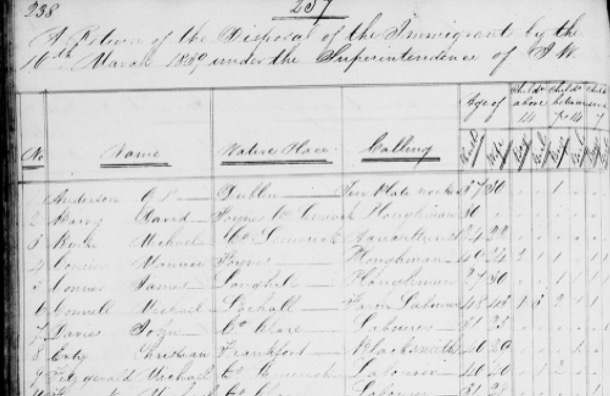
Close up of the Aliquis passenger list. Michael Bourke (misspelt as Burke) third on the list.
In an interview carried out when Catherine was a very old lady she said that they were married in Cork City, just before they left for New South Wales on the ship Aliquis,
And yet, when they arrived at Sydney, on March 2nd 1839, Michael and Catherine lost no time in seeking a priest to bless their marriage, and on Saint Patrick’s day, the ‘Banns of Marriage’ were read for the first time. It was at St Mary’s cathedral in Sydney where, 22 days later, the couple made their Vows of Marriage, on April 8th before Fr Francis Murphy and their friends from their home parish of Shanagolden, who had traveled with them from Ireland.
Work in Sydney was scarce and the ship John Barry took them along with most of their fellow travellers to the newly laid out town of Melbourne. Michael and Catherine spent their early days in Moonee Ponds, managing a dairy farm. The first three sons, James, John and Thomas were born there.
Just four years before Michael and Catherine Bourke arrived in what was then the Colony of N.S.W. Melbourne had begun its ramshackle development. John Batman, entrepreneur and settler, signed a treaty with aboriginal occupants of the Port Philip District, the Kulin nation. He promptly claimed over 500,000 acres north and west of present day Melbourne and also famously declared the present site of Melbourne’s CBD, as the place for a village. The then Governor of the Colony of NSW, Governor Bourke, became concerned at the unruly and illegal occupation of land and took charge, declaring all settlements invalid. He appointed Captain Lonsdale to represent him and run the settlement of Port Philip. Fees for grazing rights to squatters were imposed and Governor Bourke approved Hoddle’s plan for the streets of Melbourne. This is new world which Michael and Catherine entered as they stepped off the boat to begin their new life.
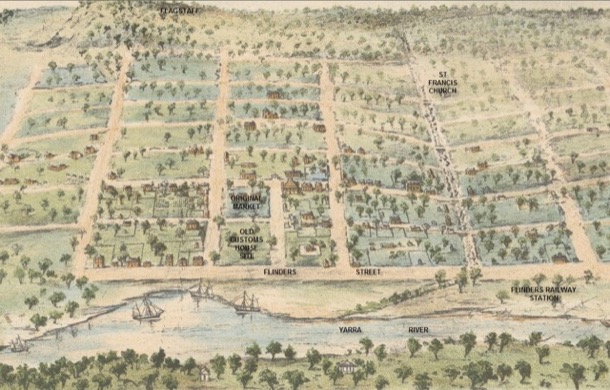
Hand drawn map of very early Melbourne, around 1837
The family moved to near Pakenham in 1844, with their friends the Nevilles, who had come out on the Aliquis with them from Limerick. Under the partnership names of Neville and Bourke, they settled in the Toomuc Valley area, taking up the “Minton’s Creek” run, which extended towards Upper Beaconsfield, 12,800 acres, about 5 square kilometres. Here, our great, great grandfather, Michael, was born in their ‘slab hut’ home in 1844.
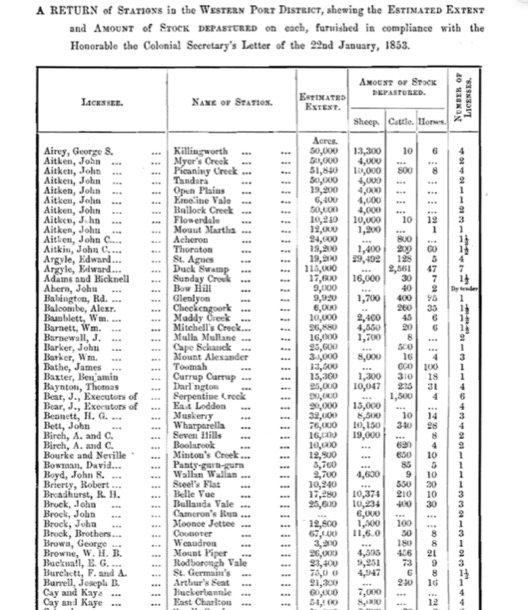
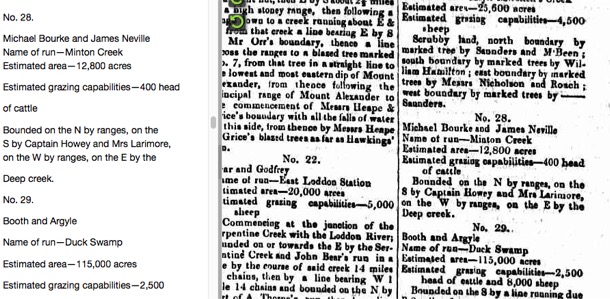
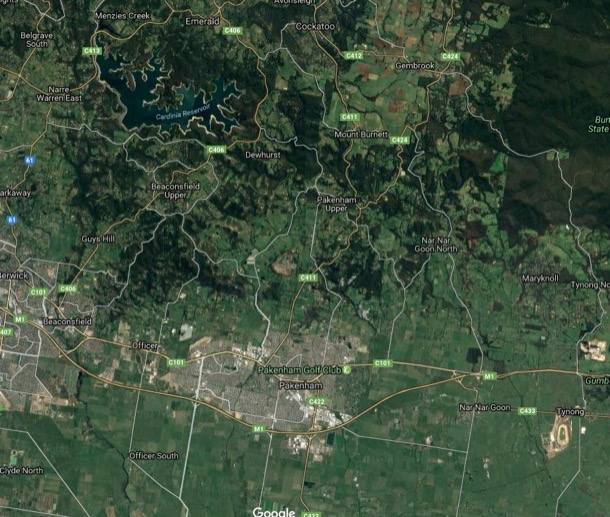
Minton's Creek Run covered the whole of present day Pakenham Upper

The Minton's Creek house site was in the centre of this aerial photo
In 1850, the Bourkes bought the Latrobe Inn, a hotel on the main Gippsland Road, where the Toomuc Creek (also known as Bourke’s Creek) crosses the main road. It became known as Bourke’s Hotel. Catherine and the seven children they had by then moved to the hotel to manage it, while Michael stayed at the station.
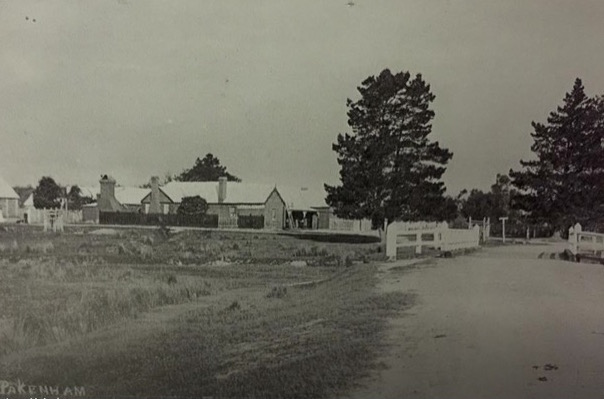
Bourke's hotel
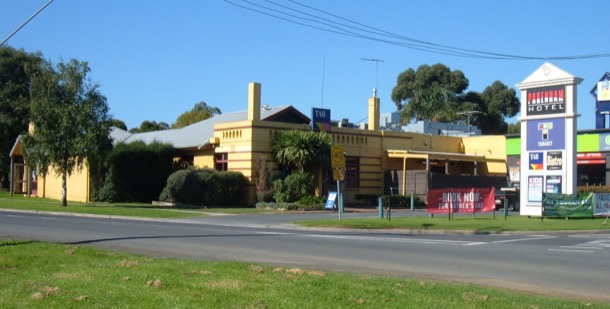
Only the original chimney stands today.
n February, 1851, after a prolonged drought, a massive bushfire covered a quarter of what is now Victoria. The smoke blew on strong hot winds, wreathing Northern Tasmania in thick smoke. It became known as Black Thursday. The story goes that Michael fought the blaze, first with water, and then milk from the dairy.
Word reached him that the hotel itself was surrounded by fire. He galloped down to Pakenham and there he found that Catherine and the children had hidden in the Toomuc Creek bed and escaped the blaze, and that the hotel itself had not burnt.

from Black Thursday, a painting in the State Library
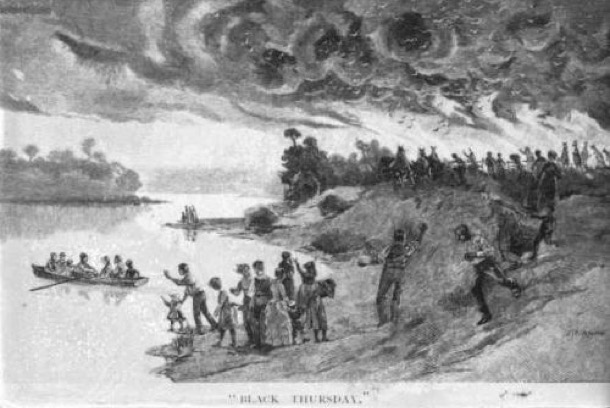
They restocked the property and in an 1853 census it was reported that Bourke and Neville had 650 cattle and ten horses on their 12,800 acres.
Bourke’s Hotel became one of the best known stopping places on the way to Gippsland. Later it became the Princes Highway Hotel and its chimney is still there today.
It was a real hub of the district. It was the polling station and the post office for the area, and Michael Bourke was postmaster at Pakenham for 30 years, and after his death, in 1877, Catherine and unmarried daughter Cecelia continued to run the post office.
In his 1942 book Memoirs of a Stockman, Harry Huntington Peck wrote:
Old Mrs. Bourke who was the landlady of the Pakenham hotel at the bridge over the Toomuc creek for so many years was an institution of the district. She was most popular with the Gippsland travellers and drovers as she took pains to make all visitors comfortable. Her fine sons David and Daniel prospered as graziers and bought good properties, the one Llowalong originally part of Bushy Park on the Avon near Stratford, and the other Old Monomeith, where the next generation Hughie and Michael, trading as Bourke Bros., are today the largest regular suppliers of baby beef to Newmarket, are well known as the owners of show teams of first-class hunters and hacks, and of late years, have been very successful in principal hurdle and steeplechase races.
It was at Bourke’s Hotel that the remainder of the children were born. There were fifteen in all, but two died in infancy.
Gradually the family grew to adulthood, and, when large areas of land were thrown open for “selection”, all the boys in turn gained properties.
Some of them are still in the hands of their descendants.
"Cut out of the Will"
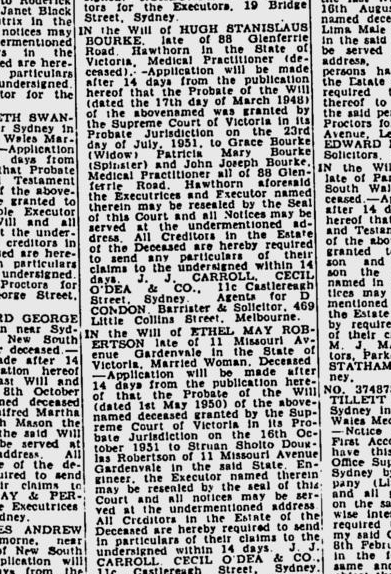
Growing up we had heard many times how our father had been ‘cut out of the will’ by his father because he had married a Protestant and renounced the Catholic faith.
As we were researching the early life of our Catholic grandmother Grace, we stumbled across the application for probate for the will of Doctor Hugh Stanislaus Bourke, our grandfather. His widow Grace, his son Jack, his daughter Patricia are mentioned but no mention of James Vincent Bourke his second son, our father.
Here, published in the Argus Newspaper, was the brutal reality of what this divide really meant in our parent’s lives. It was no small sum: 36,353 pounds. In todays world this would be equivalent to leaving an estate valued at six and a half million dollars.
More shocking is the date, on which the will was written March 17, 1948: not when they married, but three years later, when Alice was only just pregnant with their first child who was not going to be raised as a Catholic. Was this the catalyst?
Australia and the Irish Catholic/English Protestant divide.
In the very earliest days of the NSW penal colony, many of the convicts and early settlers were Irish catholics, and most of the British Military, who ran the prison colony were Anglican protestants.
The first few decades of the colony coincided with unrest and rebellion in Ireland, which was still under English rule. The authorities were nervous of the very large numbers of Irish convicts and settlers, who spoke their own language and had a different religion.
Most of Ireland became a republic and a separate country in 1922. Although there was still unrest in Northern Ireland, which remains part of England to this day, most of the official heat went out of the Irish English divide, though it remained in people’s consciousness.
Australia had an influx of European migrants in the nineteen-forties and fifties, and gradually the clear division of Australian into Catholics and Protestants became blurred, though there was still institutionalised prejudice against Catholics, right up until the 1980s.
The other: the mysterious Catholic world seen through our eyes.
Dark, heavy wooden framed paintings of the Virgin Mary and the Crucified Christ were the mysterious evidence of the Catholicism of our grandmother. We only visited Grandma Bourke’s house three or four times a year for very formal, if delicious, afternoon tea. Our relationship with her too was very formal, a peck on the cheek hello and goodbye and no spontaneous hugs and signs of affection, as we saw our cousins receive.
We knew nothing of this strange Catholic world as we were Protestant and our parents were both heavily involved at St James Presbyterian Church, Wattle Park, where there were a few bare crosses, but no other iconography.
The dark religious ‘icons’ we saw in Grandma’s house were also to be found in Uncle Jack’s house in Glenferrie Road. Most mysterious was the large porcelain statue of Mary. Mother of God, clad in a pale blue robe and further upstairs another large porcelain statue of the Crucified and Risen Christ complete with bleeding nail holes. Gruesome stuff!
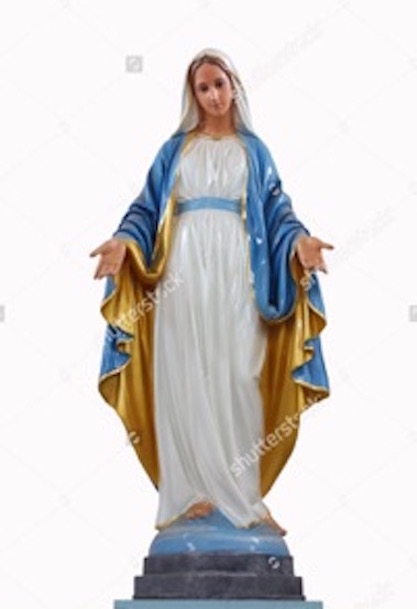
When we were growing up, even though we had Catholic relatives, we would never have gone into the Catholic Church. On several occasions we saw, at the local Catholic Church, little girls dressed up as Brides of Christ, lined up and waiting to process into the church for their First Communion.
Nuns in full habit were also very much part of our early memories. I remember back shiny lace up shoes visible under the long heavy black robes, the white starched wimple and veil and, above all, the clanking sound of the Rosary Beads and keys on a chain around their waists.

Even though, by the nineteen forties, there were Catholics in all walks of life, ordinary people still defined themselves and each other by whether they were Catholic or Protestant.
They went to separate schools, even at primary school level. If you went to a Protestant private school, you bought your uniform at Myers. Foys, another department store, catered for the Catholic ones.
Catholics were forbidden to set foot in a Protestant church. One story from this time is of the brothers of a Catholic woman marrying a Protestant forced to stand outside and watch the ceremony through the window. When Protestants and Catholics married it was called a “mixed marriage”
There was lots of name calling… “Micks”, “papists”, “proddy dogs”. Our father, attending the Catholic School in his home town of Koroit during the nineteen thirties, told us the story of him running home, chased by kids from the state school, turning and calling “proddy dogs, jump like frogs” or perhaps it was the others calling him a “Catholic dog” … probably both.
So when our father, Jim, told his Irish Catholic parents about his new girlfriend, there were probably alarm bells right from the beginning. Jim and Alice met at work, the Maribyrnong Munitions Factory.
They married in 1945, a couple of months before the end of the war. She did not dress as a bride, because it was still war time, and they had a quiet ceremony in the Congregational Church in Surrey Hills, near Alice’s home and a reception at Wattle Park Chalet.
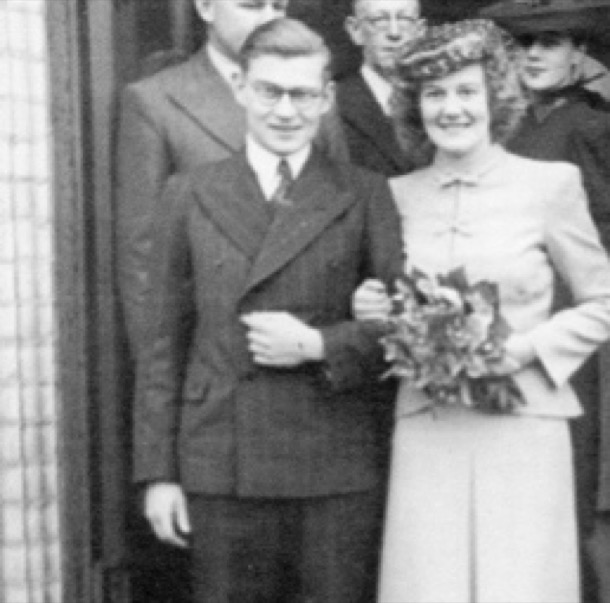
The couple lived with her parents, Alfred and Alfreda, until they built and moved into their own house in the early nineteen fifties. Alice’s parents seem to have been very tolerant. Their eldest daughter had married a Hungarian Jew a few months earlier and now their other daughter, a Catholic. Theirs was a working class family, educated and valuing education, but without much money or position in society.
Jim’s parents were from a different class as well as a different religion. Grace, as we have discovered had been a society girl and Hugh, a well respected country doctor. They did not come to the wedding. We can only imagine the conversations, the arguments, the pleading. To them, Jim’s parents, their precious son was denying himself an afterlife in Heaven, and bringing shame on the family. Any children born to this marriage would be viewed as illegitimate. In the eyes of the Catholic Church our parents were not married.
One “family story” tells of Jim’s sister, Tish, writing a letter pleading for them to “marry properly”. As children we knew that our father had “left the Catholic Church” in order to marry our mother and that he had been “cut out of the will”. It is part of our family mythology. We were aware of our mother’s bitterness at our family’s financial struggles. We witnessed the stiff courtesy with which she greeted her mother-in-law, who she always addressed as Mrs Bourke.
Now, looking at the stark reality of this newspaper article, we feel a little of her outrage. We understand better the enormity of that decision, the extraordinary timing of Hugh’s change of will, the sense of being the ‘black sheep” family that hung over us when we visited out Grandmother.
Grace McCormack, our other grandmother.
Grace McCormack was born in 1893 at the family home, called Balham Hill in Molesworth, near Yea. This is only nineteen kilometres from Sue and Jono's new property Billy Goat Hill.
Grace's father, John and mother Johanna, were highly respected and wealthy members of the community, who had bought the huge grazing property, nearly 15,000 acres, in 1886.

The house, still there today, had been built by one of the first white settlers in the area, Edward Cotton. It was near the Goulburn River, built of bricks made on the property.
The address is 1599 Whanregarwen Road MOLESWORTH
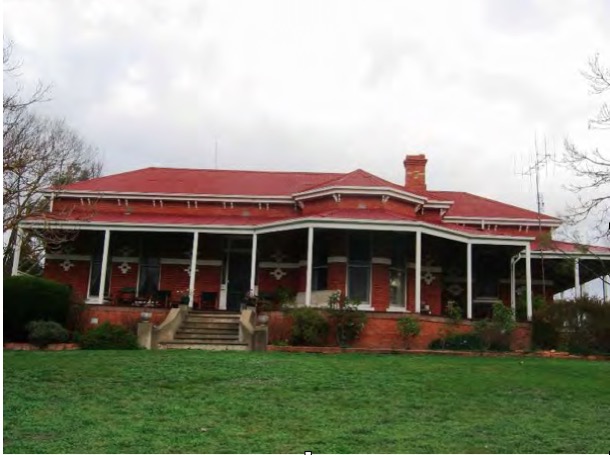
When he first arrived in the district he (Edward Cotton, who later published a book about Australian birds) wrote of the view over the valley from the Balham Hill homestead in his correspondence." I was much pleased with the beauty of the spot. The trees are rather thinly scattered over the flat, and there are extensive lagoons”. ”White cockatoos, king parrots, parakeets, eagle hawks, several species of honey-suckers and numerous tribes of smaller birds, including the bellbird, the superb warbler, etc., were plentifully scattered about this station. Ducks, black swans, divers, kingfishers, herons were constantly seen on or about the lagoons”.
HISTORY OF BALHAM HILL (from the Shire of Murrindindi Heritage Report)
The original homestead was built for Edward Cotton in 1842 or '43 using bricks made on the property. A report on the request for a pre-emptive right of June 1854 refers to a brick home, woolshed, outhouses and stables. Edward Cotton, the first squatter of Balham Hill, was born in 1803 Balham Hill, Clapham Common near London. Despite his ambitions, he failed as a pastoralist and sold Balham Hill in 1848. He died from drowning at Moorabbin in 1860, one a week after being suspended from his position as Registrar (Chief Clerk) of the County Court for 'extravagance and financial mismanagement'. In 1886 the property was sold by William Merry to John McCormack. He and his wife Johanna had five children, one of whom, Aloysius, died as an infant. The remaining children, Jane, Grace, Leo and Cyril grew up at Molesworth and attended Molesworth State School. In the early 1900s John McCormack rebuilt the homestead, retaining and incorporating into the new building some of Cotton's original homestead. The front rooms and hall were built for McCormack. The E-W passage is believed to be the front verandah of the original building, and there may have been many more rooms at the rear. During the McCormacks' time there was a circular drive at the front which was lost when road works altered the entrance. In 1930, following the death of John McCormack, the property was divided. Leo retained Balham Hill and married Zillah Maling. In 1942 Leo sold Balham Hill and moved to Melbourne. Cyril, who married Josephine Conlan in June 1930, took over a large area near Cottons Pinch and a home was built on this section. The property was named Alencon after a village in northern France. An early large orchard on the east side of the house, which includes the establishment of a Mulberry tree, was still in existence in 1994. An early rose garden once occupied the west side.
It is believed that the house originally had 17 rooms, but some of them were removed in the mid-20th century.
Births, deaths and weddings have all taken place at Balham Hill. Notably, Clara Ridd was born there during the 1870 flood. It is thought Balham Hill provided accommodation to travellers en route to the north east.
Grace was the second child. She had an older sister, Jane and three younger brothers, one of whom, Aloysius, died aged only ten months. He is buried in the Yea Cemetery. The other two boys were called Leo and Cyril. The four children all attended Molesworth State School.
John was a Justice of the Peace, a community leader, who could sign official documents and witness things for people. He donated the land for the Molesworth Community Hall.
John and Johanna had the house remodelled in the early 1900s. It had 17 rooms and a circular driveway.
The children were sent away to boarding school for their secondary education. The boys probably went to Xavier College, the girls to the Convent of Mercy in Fitzroy:
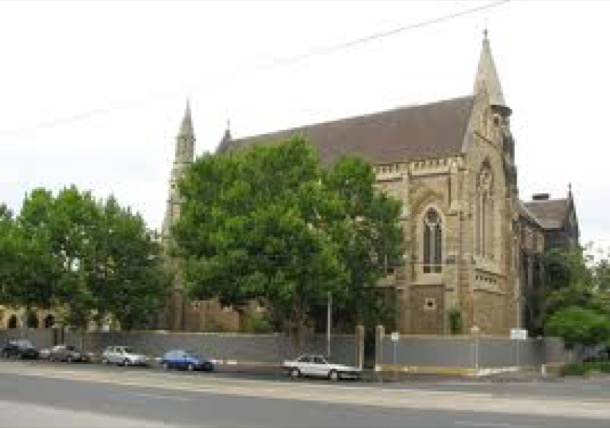
Jane was married almost exactly one month before the First World War began, in 1914: a grand affair at St Patrick’s Cathedral. Grace was her bridesmaid. The newspaper coverage of this social event is worth a read:
MR. T. M. B. COFFEY TO MISS J. McCORMACK.
The marriage of Mr. T. M. B. Coffey, third son of the late John Coffey and Mrs. Coffey, of “Kewell," Riversdale Road, Hawthorn, and Miss Jean McCormack, elder daughter of Mr. John McCormack, of "Balham Hill” Molesworth was celebrated at St. Patrick's Cathedral, Melbourne, on 27thMay.
The Rev. Father O'Reilly (Castlemaine) officiated. He
was assisted by the Rev. Father Ellis. The altar was beautifully decorated with white flowers. Miss Anderson was at the organ, and played Lohengrin's Wedding March and other beautiful music. The bride, who was given away by her father, wore a gown of soft Oriental satin, gracefully draped in straight
lines, and veiled with a short tunic of fine silk shadow lace. The beautiful court train was lined with shell pink, and finished with true lovers' knots and orange blossom. The Angel sleeves were caught and weighted with pearl tassels. The crossed bodice was of pearl embroidery, veiled with silk shadow lace. A veil of beautiful old Limerick lace (lent by the nuns) was worn, and a shower bouquet of white azaleas and fern was carried. The bridesmaid (Miss Grace McCormack) was frocked in dainty ivory crepe-de chine, the tunic of soft ninon, edged with marabout. The bodice, of soft shadow lace, was veiled with ninon, and finished with a sash of rose-pink velvet. The black velvet hat was wreathed with small winter berries and forget-me-nots. A bouquet of La France roses was carried. The train-bearers were Miss Kathleen McCormack (bride's god-child and cousin) and Miss Margaret Armond (bridegroom's god-child and cousin). They wore dainty little early Victorian dresses of white crepe-de^chine, with empire sashes, of ninon, the neck and sleeves prettily finished with white marabout. Their ninon capes were set with trails of pale pink, and they carried 1830 bouquets of small
pink roses and silver bags (gifts of bridegroom). The bridegroom's gift to the bride was a pianola piano; to bridesmaids, Nellie Stewart bangle; bride to bridegroom, beautifully fitted dressing case. Mr. Leo. McCormack (brother of bride) was best man. The bride's mother was gowned in black cashmere de soie, the skirt gracefully draped with beautiful Chantilly lace; the bodice of fine black lace, embroidered in gold, and finished with soft white tulle. A black velvet hat, set with ostrich plumes, was worn, and a bouquet of violets was carried. The bridegroom's mother and sister were unable to be present,
being at present on a visit to Dr. Coffey, in Dublin. A reception was held at, the Grand Hotel, followed by a wedding' luncheon to about seventy guests.
Later the bride and bridegroom left for Sydney, en route to New Zealand. The bride travelled in blue coat and skirt, rolled back with collar of white cloth. A black velvet hat, set with a white plume was also worn. The presents were numerous and costly, and included several substantial cheques.
So Grace was given present of a plain gold "Nellie Stewart bangle" These had become a popular fashion accessory for young Australian women in the late 19th and early 20th centuries. Usually worn on the upper arm, they were an emulation of Nellie Stewart's style. (a singing celebrity of the time)
Four years later, at the end of a gruelling four years of war, Grace herself married Hugh Stanislaus Bourke. She was twenty-five. One can’t help but speculate about those four years. How many friends did she lose? Perhaps even an earlier sweetheart.
We know her two brothers survived, because the land was divided between them when their father died in 1930.
Their wedding was a less grand affair, though still held at St Pat’s Cathedral. (Note the excitement of the aeroplane.)
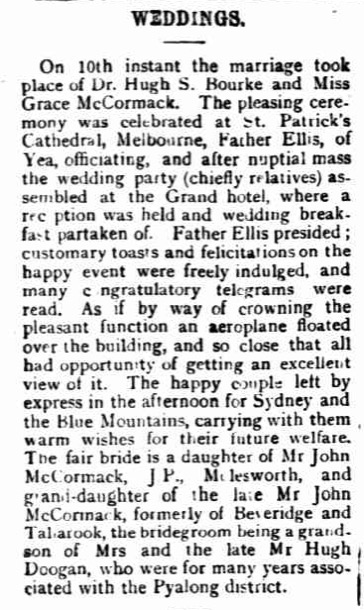
On 10th instant the marriage took place of Dr. Hugh S. Bourke and Miss Grace McCormack. The pleasing ceremony was celebrated at St. Patrick’s Cathedral, Melbourne, Father Ellis, of Yea, officiating, and after nuptial mass the wedding party (chiefly relatives) assembled at the Grand hotel, where a reception was held and wedding breakfast partaken of.
Father Ellis presided; customary toasts and felicitations on the happy event were freely indulged, and many congratulatory telegrams were read.
As if by way of crowning the pleasant function an aeroplane floated over the building, and so close that all had opportunity of getting an excellent view of it. The happy couple left by express in the afternoon for Sydney and the Blue Mountains, carrying with them warm wishes for their future welfare. The fair bride is a daughter of Mr John McCormack, J.P., Molesworth, and granddaughter of the late Mr John McCormack, formerly of Beveridge and Tallarook, the bridegroom being a grand son of Mrs and the late Mr Hugh Doogan, who were for many years associated with the Pyalong district.
Hugh had been registered as a doctor in 1907, and was, by 1918, practising in the western Victorian town of Koroit, where Grace and Hugh raised their three children.
They moved to 88 Glenferrie Road Hawthorn, home and GP surgery, during the 1930s, and stayed there until Hugh’s death in 1951, when the practice was taken over by their eldest son John.
Grace, then aged 58, moved nearby and then to Urquhart Street, Hawthorn, where we can remember visiting her, when we were children.
And a little bit about Grace's paternal grandparents:
Grace comes from quite a line of early Victorian settlers. Grace’s grandfather, also called John McCormack, had large land holdings nearby in Beveridge and Tallarook. Grace was named after her grandmother Grace Bridget, who was reported to be a generous women who was very interested in the social scene. First they lived at ‘Red Barn Farm’ in Beverage, a dairy farm with cheese making facilities including steam driven machinery. They moved to ‘Landscape’ at Tallarook in 1867. It was a much larger gazing property, also with Goulburn River frontage. Grace’s grandmother died at ‘Landscape' having spent 69 of her 83 years in the district.
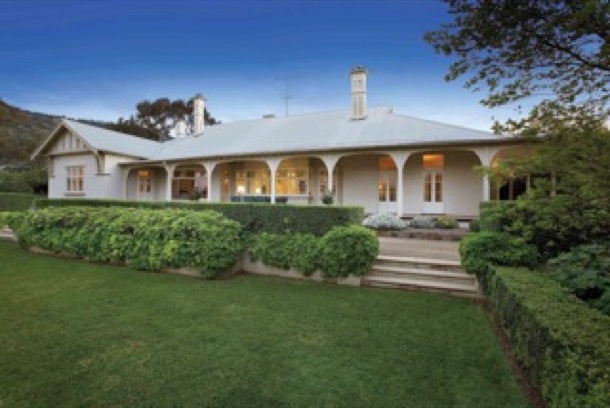
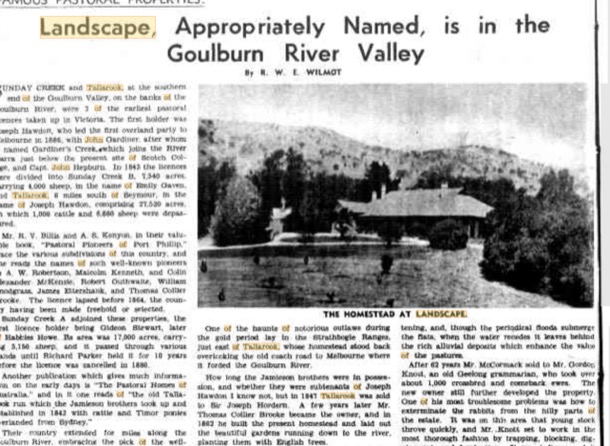
A section of this article reads:
When Tallkarook was still further subdivided in 1867, the homestead block of 3000 acres was purchased by Mr J McCormack, who named his property “Landscape”. It was only natural that in sixty years, a district so favoured by Nature within fifty-five miles of Melbourne, on the main highway from Melbourne to Sydney, should progress, and in that development Landscape shared.
The Goulburn River, with its rich alluvial flats, flanked by slopes between the frontages and the granite hills, make up an ideal property for fattening, and, though the periodical floods submerge the flats, when the water recedes it leaves behind the rich alluvial deposits which enhance the values of the pastures.
And, as an amazing postscript, Jono remembers that his mother, Janie, was school friends with a girl called Janet Essington-Lewis. Her father was the head of BHP and owned Landscape in the 1930s. Janie used to go riding at Landscape with Janet.
How to Rescue the World
ALF AND ALFREDA
Marge and Alice in their family history tapes, discuss Alfreda’s political and philosophical bent. The setting is Croydon in the 1930s. Croydon is a country town and it is the height of The Great Depression. Alf is working long hours at the Croydon Timber Yard and the family sell milk and cream from their cow. Many of their neighbours are unemployed, and homeless men come to their door to ask for work or food. In Germany, Hitler’s Nazi party is beginning to show its true colours and Russia has been a republic for less than twenty years. Alfreda is consumed by the great ideas of Politics and Economics. She shares this with Frank Hibbert, the Croydon Primary School headmaster.
Alfreda’s friend, Frank Hibbert was a progressive educator who shared her political views. His influence on the young Marge and Alice was profound.
There are also signs of early environmentalism in Alfreda’s letters. On January 16th 1935, she and Alf are camping at Yellingbo, by the creek in what is now the protected area for the Helmeted Honeyeater. She writes to Alice:
Yesterday was a beautiful day and in the evening just after sunset - oh! I wish i could tell you or show you how beautiful the bush was - for half an hour. What God has given us is so beautiful, but don’t humans muck things up - an ugly fence, a cigarette butt, an old piece of lolly paper thrown down. an old pair of shoes - everything we touch seems ugly after that beauty that I saw last night- even our bodies haven’t the beauty and grace of the wild things….. I’ll see we don’t disfigure God’s beautiful bush when we leave this lovely spot.
And later, in 1946, Alf gives us a taste of his own strong sense of social justice. He is visiting Marge in Sydney and has just received the news that Alice and Jim have managed to buy the block of land in Box Hill South that became our family home. He writes:
Your news about your block of land caused quite a lot of excitement in the family circle. Our own few square feet of land is of great importance in our lives. At last we are the possessors of what really amounts to an inheritance - a small portion of God’s earth which we can call our own. It was ordained that each man should have his share of good earth; but man overruled God’s laws and made his own, thereby making it easy enough for a rich man to obtain all the land he wants to, but placing every obstruction in the path of the poor man to obtain that which is morally his own. It is only when people, like you two, scrape to save the wherewithal, that you get your share, or rather, a very small portion of it. But I must keep off my pet theme.
ALICE AND JIM
This was the value system that Alice, our mother, has passed on to us. We were never in any doubt about which side of any particular issue was the correct one.
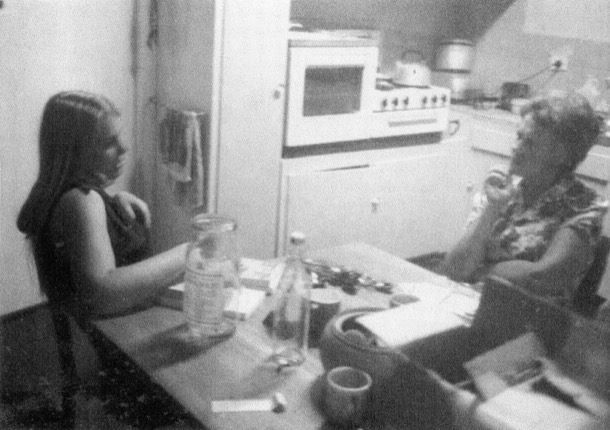
Margaret and Alice at the Moore Street kitchen table
Both Alice and Jim, our father, were staunch Labour voters, and had a strong commitment to social justice.
The world’s first atomic bomb was detonated in Japan in 1945, followed by a nuclear arms race between the USA and the USSR. Bombs were tested, and people felt that there was a constant threat of war breaking out again. Alice and Jim and a like-minded couple from our street were involved in the call for unilateral nuclear disarmament. Another neighbour, Judah Watten, a writer and a communist, was also a member of this “leftist” protest group. This was the time of anti communist McCarthyism in America, and Jim and Alice’s actions were quite radical.
Alice became more confident and able to hold her own in conversations over these years. There were many discussions around our Moore Street kitchen table about the social or political issue of the moment.
Christian social justice became her main focus during her fifties and sixties.
She was active in a number of left wing church organisations. I remember in 1975, when I was living in the country, listening to her talk on the radio about third world poverty. Even in her later years, blind and housebound, she would listen avidly to the radio and talk about politics to anyone who would listen.
Of Jim, we have fewer memories. We remember marching with him in a teachers' protest on the issue of State Aid to private schools. We are now quite used to Governments providing money to private schools, but, when first mooted by the Menzies Government, it was greeted with outrage by many. One of Jim’s concerns during the march was that he would appear on the television news and be seen by his conservative, Catholic, Liberal voting mother.
Jim was a member of the Board of Management of our family’s church, St James, Wattle Park. He was outraged when he discovered the cost of the new church building. He resigned over the issue. In his view the money would have been better spent elsewhere. This is evidence of the strength of his principles, as his role in the church was important to him.
SUE
My memories of my early twenties and engagement in ‘protest’ is of the outrage of youth. ‘How dare they!’
During my last year at College and my first years of teaching, the VSTA, the union representing secondary teachers, was very active in a campaign to improve teaching conditions. I had had an early introduction to strike action by teachers when Margaret and I marched with Dad over state aid to non government schools so I was an eager participant in the ferment.
In outrage that the State Government would contemplate increasing class sizes and teaching allotments, a couple of friends and I formed a VSTA branch and began conducting meetings. I remember calling a strike meeting and organising a boycott of classes that we were convinced would change the world. It didn't! Fancy that! We were still fighting this battle during our first years of teaching.
A much more serious concern was the Vietnam War that the US had been involved in for years and, unbeknown to the public, so had Australia! Prime Minister Menzies had mislead the Parliament and the public, and had committed Special Forces to fight in Vietnam. His successor, Harold Holt, invoking the ANZUS Treaty, upped our level of support and, as the war dragged on with no victory in sight, National Service or conscription was introduced. My family and friends were all very much against the war and the deceptive and high handed action by successive Liberal Governments. Outrage and protest was a consuming passion.
It was sometimes a bit scary! In the early days before the huge moratoriums, the numbers protesting were considerable but not large, and the police seemed to be a threatening and sinister presence. I remember the July 4th 1967 protest outside the American Consulate in St Kilda Road. I went to this one with Mum and Margaret.
It was dark as we arrived and stood with the other protesters outside the closed front gates to the Consulate. There was no visible presence in the building, as we held our anti-war banners and chanted slogans. The most sinister aspect was watching the police buses pull up across the park and disgorge many, many policemen. I remember thinking, ‘Can this be Australia?’ A noisy and highly visible minority of the protesters were quite confrontational and aggressive and were consequently arrested. We stayed well clear of the action but it was hard to avoid the police horses. They are enormous up front and personal, and were used very effectively to nudge the crowd away from the gates. Overall it was a very sobering experience and one that has stayed with me. We live in a democracy with the right to protest peacefully. What must it be like protesting under less benign circumstances?
After these small beginnings the protest numbers swelled, culminating in the euphoria of the Moratorium Marches that brought cities across the world to a standstill, including Melbourne.

The ABC captures the spirit and the times better than I can. Have a look:
http://www.abc.net.au/archives/80days/stories/2012/01/19/3411534.htm
Even though I may have wished for many thousands to take to the streets again, as they did in the Moratoriums, it has not happened on such a scale, but here’s hoping!!
The demonstrations against the Vietnam War left a profound legacy. After such a powerful and successful protest movement, it seems the natural response to feelings of outrage: paint a banner and march! As Margaret says, ‘It is part of democracy’. Aren't we lucky!
Therefore, along with thousands of other concerned people, I have attempted to ban nuclear weapons, stop the war in Iraq, stop logging of old growth forests in Tasmania and East Gippsland and persuade our government to take action to reduce emissions.
The world has changed, but not always for the better. Today, as well as the kitchen table, the letter, the banner and the march, we have at our disposal the power of global and instant communication and social media. It is the era of Get Up and ’Clicktivism’.
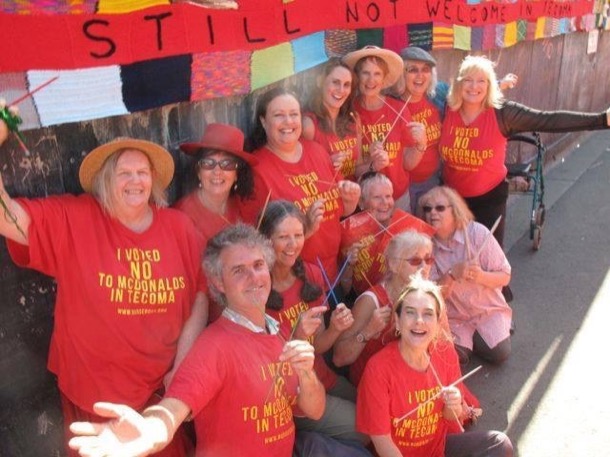
Sue and Margaret protesting together at Tecoma
MARGARET
July 4th 1967. It is winter in Melbourne and it is raining. The puddles flash …blue…black…blue…black…
“Link arms!” call the young bearded marshalls running up and down the line of marchers. We are marching on the American Embassy, protesting atrocities in Vietnam, pressurising our government to change their “All the way with LBJ” policy. Police horses charge the crowd. One of my companions, my forty-three year old mother, loses her handbag.
Five years later a New Yorker I go out with a few times, assures me that there would have been fully armed Marines in the embassy, and that they wouldn’t have hesitated to shoot, had we successfully “stormed” the building.
This was my first real “demo”. I don’t remember why it was just my sister, my mother and I there. I was fifteen.
Over the ensuing fifty years, I have waved banners demanding many things: the end to the logging of old growth forests and the creation of National parks; that uranium be left in the ground; that there be land rights for our indigenous populations; smaller class sizes; a fairer allocation of education funds and more of them; that we not go to war and/or bring our troops home; that the public service not be decimated by cuts; that the separation of power between the judiciary, the legislature and the executive be maintained; that MacDonald’s stay out of our Hills community.
Most recently I marched with Michael and Chris to urge our planet to act on Climate Change:
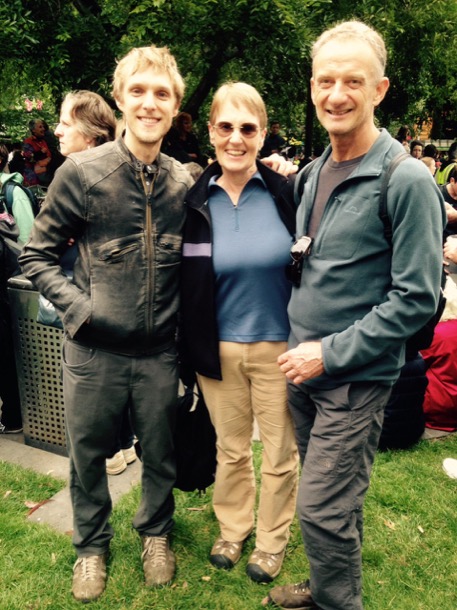
Marching for climate justice... a family affair
The thread that links these causes, is the same thread that runs back to the 1930s around the Coates’ dinner table in Croydon. It involves words like environment, justice, democracy, fairness, equity, peace, kindness and conservation.
Jim's Schooling
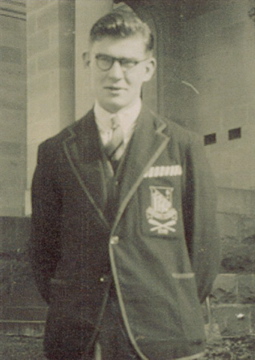
Jim in his Xavier uniform.
Stories of Jim’s childhood in Koroit have largely been lost, but he went to the Catholic Primary School there, and spoke of the strict nuns, his teachers, walking up and down between the rows of desks, wielding a ruler.
We can picture him, rushing home after school, calling to the family's protective Airedale dog. Often he was pursued by the non-Catholic kids and would call to them from the safety of the gate, “Proddy dogs, jump like frogs, in and out the water.”
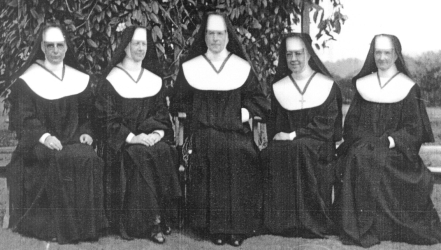
Sisters of the Good Samaritan of the Order of St Benedict.

St Patricks Primary School, Koroit, today.
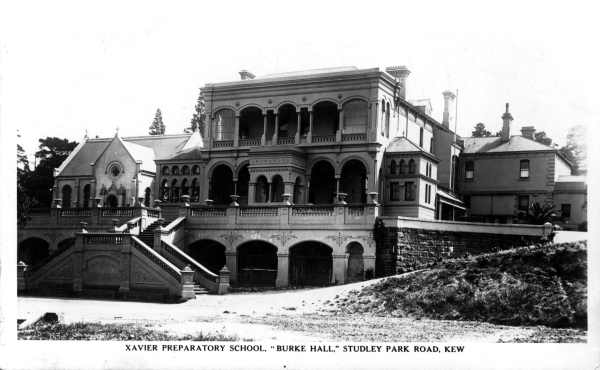
Burke Hall, Xavier Preparatory School, Kew.
In 1932, Jim was sent to boarding school in Kew. Initially he lived at Burke Hall, the junior school of Xavier College.
We have only snippets of information about these years. But it doesn’t take much imagination to picture his life.
Jim would have arrived at the big city school, aged just eleven, with the weight of family expectations to follow his father into a career in medicine. Jim had poor eyesight and his interests lay with practical skills.
To make matters worse, Jack, his older, more academically successful brother was already at the school, fulfilling parental expectations.
Alice used to say “Jim should have been sent to a tech school”. In his later years, Jim spoke with loathing of the Jesuit priests, known for their strict discipline and preference for academia. He must have hated the long hours of study in cold study halls.
Susan and Margaret remember a time during the annual camping holiday when, disgusted by the gluttony of toast eating competitions, Jim made them eat their toast as he had been taught to at Xavier, placing a lump of butter and a spoon of jam on the plate, and spreading each individual, carefully cut mouthful. His had been a very regulated life.
As an older student, he was particularly successful in the rowing team. His name is on an honour board at Xavier College, as “ the stroke” in the prestigious rowing eight. He participated in the “Head of the River” regatta, the oldest schoolboy rowing event in the world dating back to 1868.
